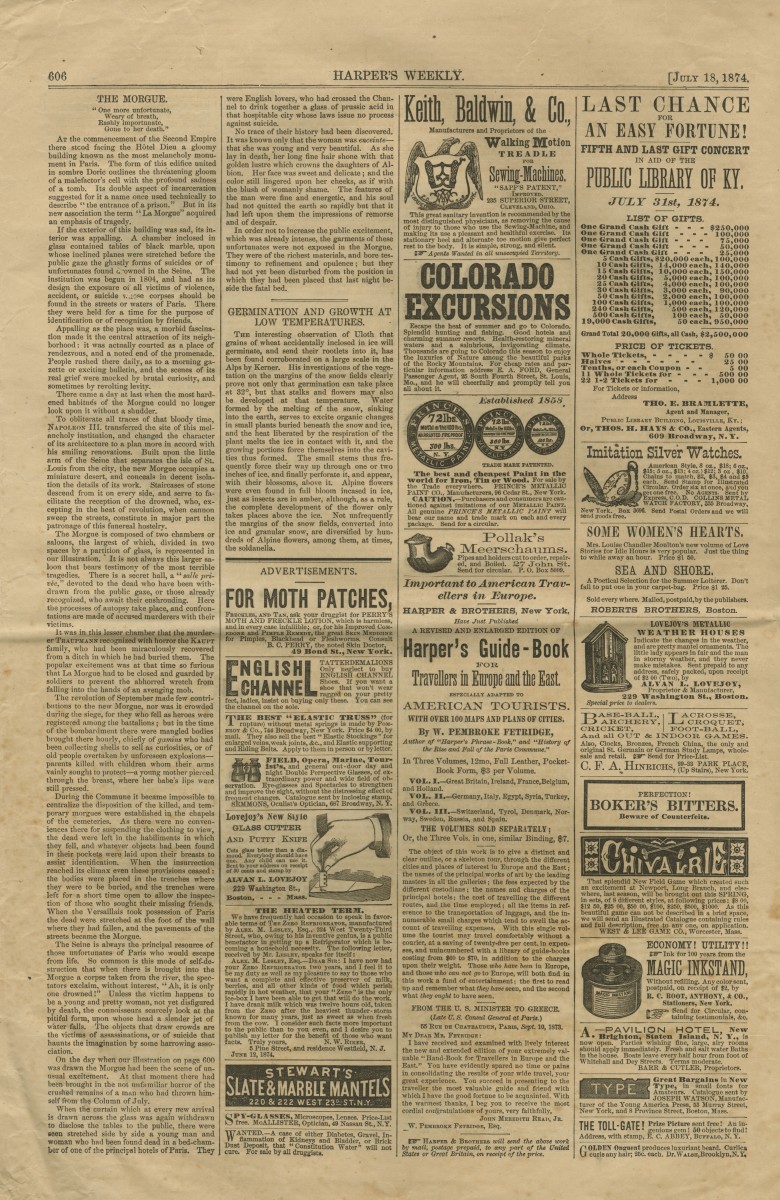-
 Artist: Utagawa Kunisada [歌川 国貞] a.k.a. Utagawa Toyokuni III [三代歌川豊国] (Japanese, 1786 – 1865). Block cutter: Yokokawa Takejirō [横川竹二郎] (Japanese, fl. 1845 – 1863), seal Hori Take [彫竹]. Publisher: Ibaya Senzaburō [伊場屋仙三郎] (Japanese, fl. C. 1845 – 1847). Title: Book of an incoming ship [入船帳] (Irifune-chō). Series: Comparison of Eight Books of Proficiency and Eloquence [口も手も美立八帳] (Kuchimo temo mitate hatchō). Date seal and aratame censor seal: 1856 (Ansei 3). Signed: Toyokuni ga in toshidama cartouche. Media: Untrimmed fan print (uchiwa-e), 231 x 300 mm. Provenance: The Collection of Paul F. Walter, Christie's, New York, 2017, lot 341; sold together with 5 other fan prints for $25,000. Before: Israel Goldman, Japanese Prints, Catalogue 11, 2005, no. 37. Ref: [LIB-1693.2018] The Collection of Paul Walter. — NY: Christie's, 2017, p. 363. Ref: Israel Goldman, Catalogue 2018, № 51: "Utagawa Kunisada (1786-1865) A Beauty Seated in a Boat. From the series Mitate hatcho (A Parody of Eight Books). 1856. Fan print. 23.3 x 30 cm. Provenance: Israel Goldman, Japanese Prints, Catalogue 11, 2005, no. 37, The Collection of Paul F. Walter, Christie's, New York, 2017, lot 341. Fine impression, colour and condition. The title contains the saying: “Kuchi mo hatcho te mo hatcho (As quick with one’s hand as one’s tongue)." Special thanks to Horst Graebner for the detailed description.
Artist: Utagawa Kunisada [歌川 国貞] a.k.a. Utagawa Toyokuni III [三代歌川豊国] (Japanese, 1786 – 1865). Block cutter: Yokokawa Takejirō [横川竹二郎] (Japanese, fl. 1845 – 1863), seal Hori Take [彫竹]. Publisher: Ibaya Senzaburō [伊場屋仙三郎] (Japanese, fl. C. 1845 – 1847). Title: Book of an incoming ship [入船帳] (Irifune-chō). Series: Comparison of Eight Books of Proficiency and Eloquence [口も手も美立八帳] (Kuchimo temo mitate hatchō). Date seal and aratame censor seal: 1856 (Ansei 3). Signed: Toyokuni ga in toshidama cartouche. Media: Untrimmed fan print (uchiwa-e), 231 x 300 mm. Provenance: The Collection of Paul F. Walter, Christie's, New York, 2017, lot 341; sold together with 5 other fan prints for $25,000. Before: Israel Goldman, Japanese Prints, Catalogue 11, 2005, no. 37. Ref: [LIB-1693.2018] The Collection of Paul Walter. — NY: Christie's, 2017, p. 363. Ref: Israel Goldman, Catalogue 2018, № 51: "Utagawa Kunisada (1786-1865) A Beauty Seated in a Boat. From the series Mitate hatcho (A Parody of Eight Books). 1856. Fan print. 23.3 x 30 cm. Provenance: Israel Goldman, Japanese Prints, Catalogue 11, 2005, no. 37, The Collection of Paul F. Walter, Christie's, New York, 2017, lot 341. Fine impression, colour and condition. The title contains the saying: “Kuchi mo hatcho te mo hatcho (As quick with one’s hand as one’s tongue)." Special thanks to Horst Graebner for the detailed description. -
 An uncut fan print showing Otsu-e [大津絵] (Otsu pictures). Artist: Utagawa Sadahide [歌川貞秀] (Japanese, 1807 – 1879). Signed: Gountei Sadahide ga [五雲亭貞秀画] (Picture by Gountei Sadahide); characters on the Otsu-e. Publisher: Ibaya Senzaburō [伊場屋仙三郎] (Japanese, c. 1815 – 1869). Published: c. 1849. Inscription in a paper-weight shaped cartouche: [大津追 分絵の図] Ōtsu-oi wake-e no zu (Following Otsu – image of separate pictures) No date seal, no censor seal (privately printed?) Media: Fan print (uchiwa-e, 団扇絵), 235 x 298 mm.
An uncut fan print showing Otsu-e [大津絵] (Otsu pictures). Artist: Utagawa Sadahide [歌川貞秀] (Japanese, 1807 – 1879). Signed: Gountei Sadahide ga [五雲亭貞秀画] (Picture by Gountei Sadahide); characters on the Otsu-e. Publisher: Ibaya Senzaburō [伊場屋仙三郎] (Japanese, c. 1815 – 1869). Published: c. 1849. Inscription in a paper-weight shaped cartouche: [大津追 分絵の図] Ōtsu-oi wake-e no zu (Following Otsu – image of separate pictures) No date seal, no censor seal (privately printed?) Media: Fan print (uchiwa-e, 団扇絵), 235 x 298 mm. -
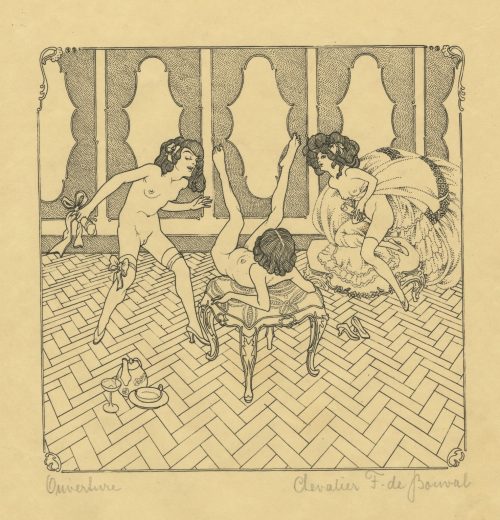 A set of sixteen planographic prints, signed and titled in pencil by owner “Chevalier F. de Bouval” (pseudonym of Franz von Bayros (Austrian, 1866 – 1924). Titles include: 1) Ouverture, 2) champagne brut, 3) maternité, 4) piano, 5) crudité délicieuse, 6. la belle vue, 7) au pensionnat, 8) le collier, 9) languelles pénètrelles, 10) introduction, 11) le sourrogat, 12) variation amoureuse, 13) la surprise, 14) le clef délicat, 15) le monstre gomme, 16) fruits de sud. Printed on wove paper, possibly engraved on wood after ink drawings by Franz von Bayros (Austrian, 1866 – 1924) under the pseudonym Chevalier F. de Bouval. Size: sheet 30 x 24 cm, image 18 x 17.5 cm. In another source, there are two more images from the same set: le passe-partout and la doublette, making 18 images altogether; the set is titled “Lesbia: XVIII sujets”, signed by Chevalier François René de Bouval.
A set of sixteen planographic prints, signed and titled in pencil by owner “Chevalier F. de Bouval” (pseudonym of Franz von Bayros (Austrian, 1866 – 1924). Titles include: 1) Ouverture, 2) champagne brut, 3) maternité, 4) piano, 5) crudité délicieuse, 6. la belle vue, 7) au pensionnat, 8) le collier, 9) languelles pénètrelles, 10) introduction, 11) le sourrogat, 12) variation amoureuse, 13) la surprise, 14) le clef délicat, 15) le monstre gomme, 16) fruits de sud. Printed on wove paper, possibly engraved on wood after ink drawings by Franz von Bayros (Austrian, 1866 – 1924) under the pseudonym Chevalier F. de Bouval. Size: sheet 30 x 24 cm, image 18 x 17.5 cm. In another source, there are two more images from the same set: le passe-partout and la doublette, making 18 images altogether; the set is titled “Lesbia: XVIII sujets”, signed by Chevalier François René de Bouval. -
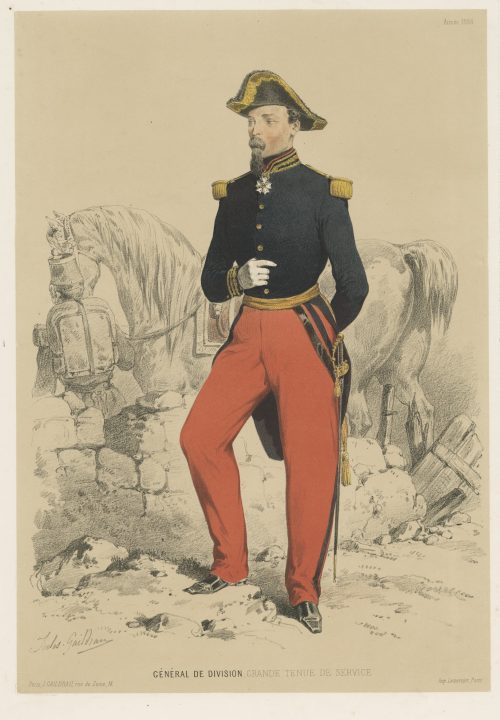 Chromolithography on thick wove paper, 473 x 315 mm sheet, 372 x 260 mm image, black ink stamp “5050” to reverse. Signed on stone "Jules Gaildrau"; below centre: "GÉNERAL DE DIVISION, GRANDE TENUE DE SERVICE"; Bottom left: "Paris, J. Gaildrau, rue de Seine, 16"; right: "Imp. Lemercier, Paris." Joseph Lemercier (French, 1803 – 1887) – printer. Jules Gaildrau (French, 1816 – 1898) – artist.
Chromolithography on thick wove paper, 473 x 315 mm sheet, 372 x 260 mm image, black ink stamp “5050” to reverse. Signed on stone "Jules Gaildrau"; below centre: "GÉNERAL DE DIVISION, GRANDE TENUE DE SERVICE"; Bottom left: "Paris, J. Gaildrau, rue de Seine, 16"; right: "Imp. Lemercier, Paris." Joseph Lemercier (French, 1803 – 1887) – printer. Jules Gaildrau (French, 1816 – 1898) – artist. -
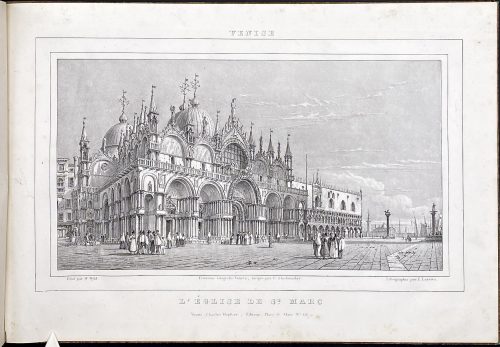 Owner's convolute binding of the period in quarter tan cloth, yellow marbled boards, no title page, no pagination. Contents: (1) Venetian Album –12 lithographs by Émile-Aubert Lessore (French, 1805 – 1876) after William Wyld (British, 1806 – 1889). — Venice: Charles Hopfner, [1834]. Printed at Premiata Litografia Veneta under the direction of Ferdinand Wolfgang Flachenecker (German, 1782 – 1847). Inscription: Premiata Litografia Veneta, dirigée par C. Flachenecker.
Owner's convolute binding of the period in quarter tan cloth, yellow marbled boards, no title page, no pagination. Contents: (1) Venetian Album –12 lithographs by Émile-Aubert Lessore (French, 1805 – 1876) after William Wyld (British, 1806 – 1889). — Venice: Charles Hopfner, [1834]. Printed at Premiata Litografia Veneta under the direction of Ferdinand Wolfgang Flachenecker (German, 1782 – 1847). Inscription: Premiata Litografia Veneta, dirigée par C. Flachenecker.- L'Église de St. Marc
- La place St. Marc
- Le palais Ducal
- Le Môle
- L'Arsenal
- La Riva dei Schiavoni
- Le Grand Canal, (1re vue)
- Le Grand Canal (2me vue)
- Le Grand Canal (3me vue)
- Le Grand Canal (4me vue)
- Le Grand Canal (5me vue)
- Le Grand Canal (6me vue)
- Title: Spiegazione / delli quattro prospetti dei bassi rilievi in marmo che circondano le mura della S. Casa di Loreto / qui annessi in puntata, oltre l'altro prospetto del palazzo pontificio / facciata del tempio, campanile, e cuppola etc.
- Prospetto della Basilica, e Piazza Lauretana, ed annesso Palazzo Apostolico / V. Jaffei incise.
- Settentrione. Prospetto laterale de Bassirilievi in Marmo, che circondano le Mura di S. Casa di Loreto. Jaffei incise Loreto.
- Oriente. Prospetto de Bassirilievi in Marmo, che circ=ondano le Mura di S. Casa. Jaffei incise Loreto l'Anno 1828.
- Mezzo Giorno. Prospetto laterale de Bassirilievi in Marmo, che circondano le Mura di S. Casa di Loreto. Jaffei dis. ed inc. in Loreto.
- Occidente. Prospetto de Bassirilievi in Marmo, che circ=ondano le Mura di S. Casa. Jaffei dis. ed inc. in Loreto l'Anno 1828.
-
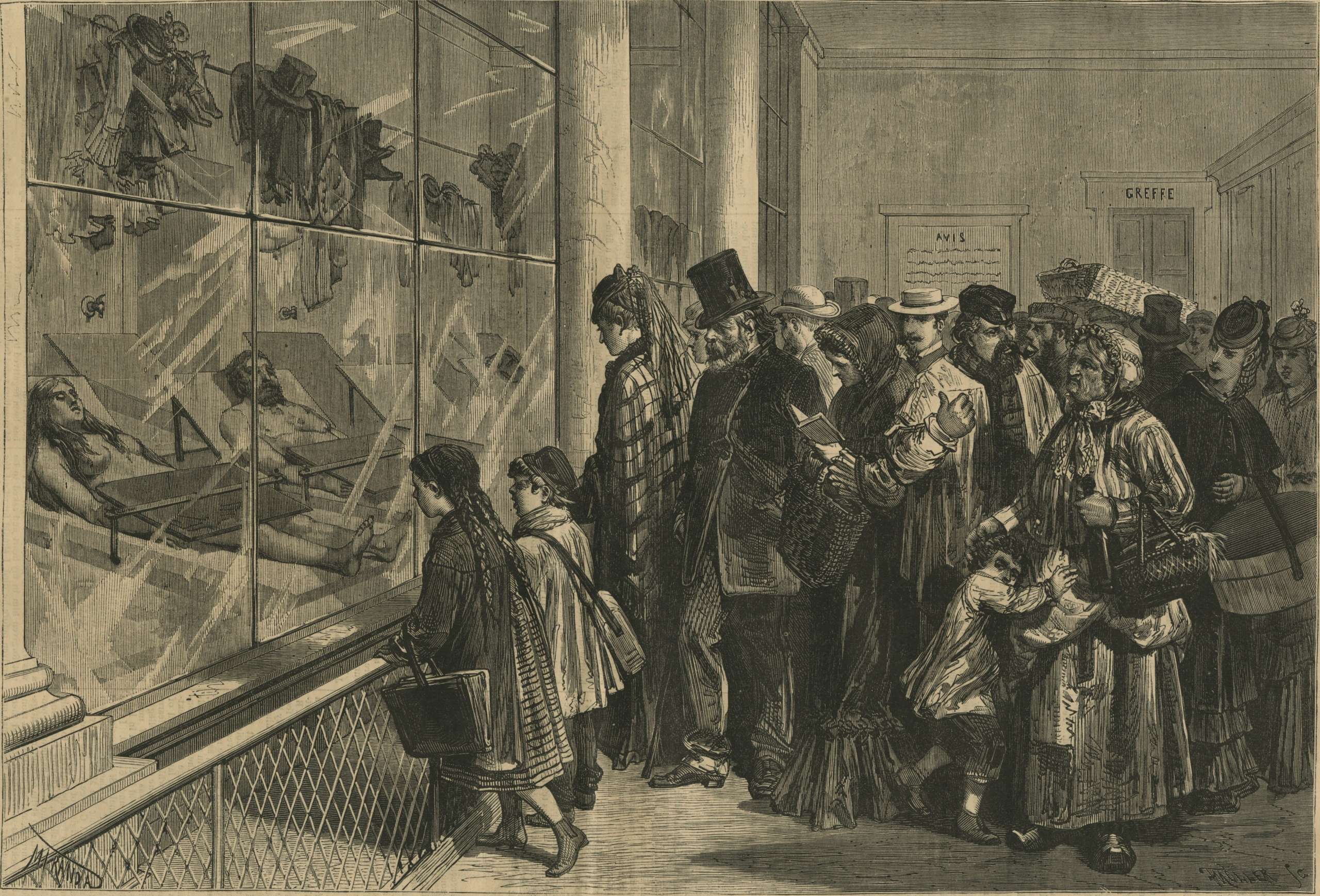
-
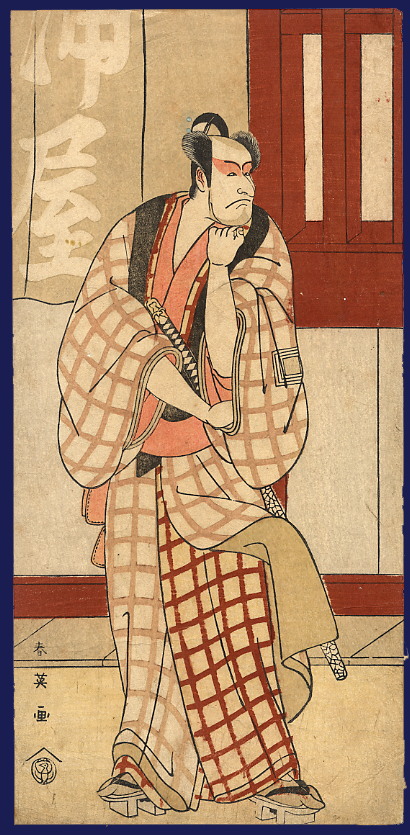 Print by Katsukawa Shun'ei that presumably depicts a kabuki actor Ichikawa Monnosuke II. I was not able to find any reference of the image. Size: Hosoban. SOLD
Print by Katsukawa Shun'ei that presumably depicts a kabuki actor Ichikawa Monnosuke II. I was not able to find any reference of the image. Size: Hosoban. SOLD -

Kitagawa Tsukimaro (Kikumaro): 喜多川 月麿, fl. c. 1794–1836.
Mother is playing with her child: they left playing with shadow lantern for freeing a turtle (Hojo-e, or "Rite for the Release of Living Beings").Signed: Tsukimaro hitsu (月麿筆); Publisher's mark; censor's seal: Kiwame + Yamaguchiya Tôbei gyōji seal (1811-14).
-
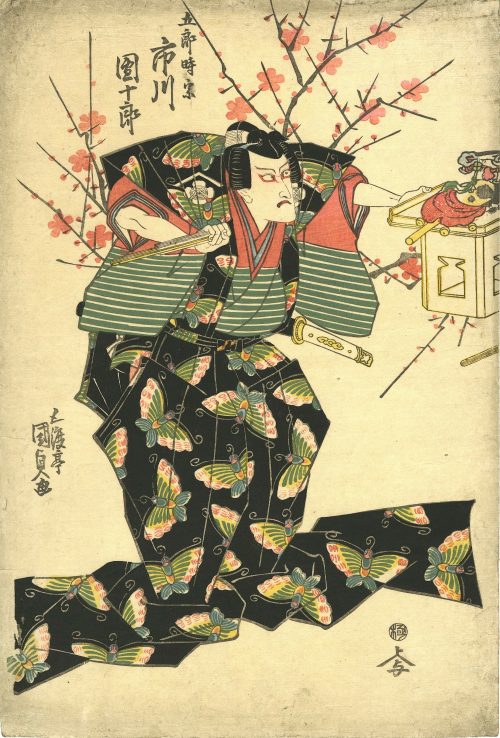 Actor Ichikawa Danjuro VII as Soga Goro Tokimune (one of the Soga brothers). Ichikawa Ebizô V held the name of Ichikawa Danjûrô VII from the 11th lunar month of 1800 to the 2nd lunar month of 1832. Artist: Utagawa Kunisada (Toyokuni III) [歌川 国貞] (Japanese, 1786 – 1865) Publisher: Uemura Yohei (Japanese, 1750 – 1832). Date: 1830 Size: Vertical ōban Signatures/Marks: Gototei Kunisada ga. Publisher's seal: Uemura Yohei. Censor's seal: Kiwame
Actor Ichikawa Danjuro VII as Soga Goro Tokimune (one of the Soga brothers). Ichikawa Ebizô V held the name of Ichikawa Danjûrô VII from the 11th lunar month of 1800 to the 2nd lunar month of 1832. Artist: Utagawa Kunisada (Toyokuni III) [歌川 国貞] (Japanese, 1786 – 1865) Publisher: Uemura Yohei (Japanese, 1750 – 1832). Date: 1830 Size: Vertical ōban Signatures/Marks: Gototei Kunisada ga. Publisher's seal: Uemura Yohei. Censor's seal: Kiwame -
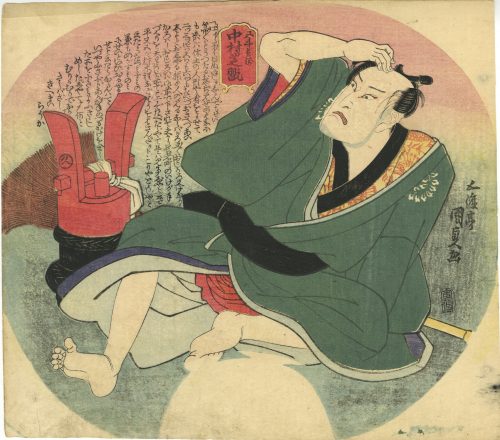 Artist: Utagawa Kunisada [歌川 国貞] a.k.a. Utagawa Toyokuni III [三代歌川豊国] (Japanese, 1786 – 1865). Signed: Gototei Kunisada ga [五渡亭国貞画]. Publisher: Ibaya Kyūbei [伊場屋 久兵衛] (Japanese, 1804 – 1851); seal Marks 08-055|126a. Date-aratame seal: Bunsei 13 / Tenpō 1 (1830). Actor: Nakamura Utaemon IV [中村歌右衛門] (Japanese, 1796 – 1852); other names: Nakamura Shikan II [中村芝翫], Nakamura Tsurusuke I, Nakamura Tōtarō. Play: Yoshitsune’s Letter at Koshigoe [義経腰越状] (Yoshitsune Koshigoe-jo). Uncut fan print (uchiwa-e, 団 扇 絵) depicting kabuki actor Nakamura Shikan [中村芝翫] as Gotobei [五斗兵衛], dressed in a green kimono with hanging wisteria crest (sagari fuji mon) on the shoulder, posing behind a large saké cask. Nakamura Utaemon IV held the name of Nakamura Shikan II from the 11th lunar month of 1825 to the 1st lunar month of 1836. He was born as Hirano Kichitarō in Edo in 1796. Another fan print with the same subject in this collection [SVJP-0349.2021]; there are also more details about the play and its heroes.
Artist: Utagawa Kunisada [歌川 国貞] a.k.a. Utagawa Toyokuni III [三代歌川豊国] (Japanese, 1786 – 1865). Signed: Gototei Kunisada ga [五渡亭国貞画]. Publisher: Ibaya Kyūbei [伊場屋 久兵衛] (Japanese, 1804 – 1851); seal Marks 08-055|126a. Date-aratame seal: Bunsei 13 / Tenpō 1 (1830). Actor: Nakamura Utaemon IV [中村歌右衛門] (Japanese, 1796 – 1852); other names: Nakamura Shikan II [中村芝翫], Nakamura Tsurusuke I, Nakamura Tōtarō. Play: Yoshitsune’s Letter at Koshigoe [義経腰越状] (Yoshitsune Koshigoe-jo). Uncut fan print (uchiwa-e, 団 扇 絵) depicting kabuki actor Nakamura Shikan [中村芝翫] as Gotobei [五斗兵衛], dressed in a green kimono with hanging wisteria crest (sagari fuji mon) on the shoulder, posing behind a large saké cask. Nakamura Utaemon IV held the name of Nakamura Shikan II from the 11th lunar month of 1825 to the 1st lunar month of 1836. He was born as Hirano Kichitarō in Edo in 1796. Another fan print with the same subject in this collection [SVJP-0349.2021]; there are also more details about the play and its heroes. Horst Graebner also noted that the performance took place at Nakamura Theatre in Edo on Bunsei 13/03 (03/1830) (see Waseda University Cultural Resources Database # 100-4224):
Horst Graebner also noted that the performance took place at Nakamura Theatre in Edo on Bunsei 13/03 (03/1830) (see Waseda University Cultural Resources Database # 100-4224):

Toyokuni II
-
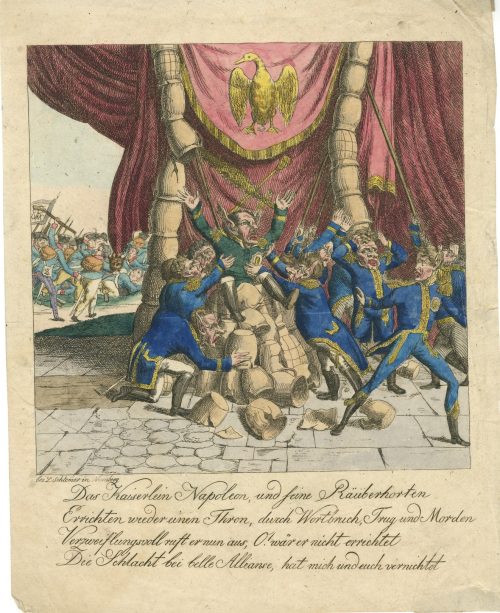 Hand-coloured etching by L. Schlemer from Nürnberg, printed in c. 1815. Napoleon, with long ears, is seated on a throne made of a pile of crockery, which is falling over. Referring to the Battle of Waterloo. See p. 134 in vol. 2 of A. M. Broadley. Napoleon in caricature, 1795-1821. — London, New York: John Lane, 1911.
Hand-coloured etching by L. Schlemer from Nürnberg, printed in c. 1815. Napoleon, with long ears, is seated on a throne made of a pile of crockery, which is falling over. Referring to the Battle of Waterloo. See p. 134 in vol. 2 of A. M. Broadley. Napoleon in caricature, 1795-1821. — London, New York: John Lane, 1911. -
 An uncut fan print showing a young woman checking her makeup in a mirror from the series The pride of Edo [江戸じまん] (Edo jiman). The head portrait in the red circle is of kabuki actor Danjūrō VII. Ichikawa Danjūrō VII [市川団十郎] (Japanese, 1791 – 1859); other names: Ichikawa Ebizō V, Ichikawa Hakuen II, Ichikawa Shinnosuke I. Artist: Utagawa Kunisada [歌川 国貞] a.k.a. Utagawa Toyokuni III [三代 歌川 豊国] (Japanese, 1786 – 1865). Publisher: Ibaya Kyūbei [伊場屋 久兵衛] (Japanese, fl. 1804 – 1851). Artists signature: Ōkō Kunisada ga [應好国貞画] (Drawn to satisfy the taste of Kunisada) Publisher’s seal:久 – Ibakyū [伊場久]. Censor's seal: Kiwame; date seal: Bunsei 10 (1827). Saze: Aiban uchiwa-e; 23.2 x 28.9 cm. Ref.: [LIB-2967.2022] Utagawa Kunisada (1786 – 1865): His world revisited / Catalogue № 17, Exhibition March 17-21, 2021. — NY: Sebastian Izzard, LLC., 2021; p. 102, Cat. 28–fig. a.
An uncut fan print showing a young woman checking her makeup in a mirror from the series The pride of Edo [江戸じまん] (Edo jiman). The head portrait in the red circle is of kabuki actor Danjūrō VII. Ichikawa Danjūrō VII [市川団十郎] (Japanese, 1791 – 1859); other names: Ichikawa Ebizō V, Ichikawa Hakuen II, Ichikawa Shinnosuke I. Artist: Utagawa Kunisada [歌川 国貞] a.k.a. Utagawa Toyokuni III [三代 歌川 豊国] (Japanese, 1786 – 1865). Publisher: Ibaya Kyūbei [伊場屋 久兵衛] (Japanese, fl. 1804 – 1851). Artists signature: Ōkō Kunisada ga [應好国貞画] (Drawn to satisfy the taste of Kunisada) Publisher’s seal:久 – Ibakyū [伊場久]. Censor's seal: Kiwame; date seal: Bunsei 10 (1827). Saze: Aiban uchiwa-e; 23.2 x 28.9 cm. Ref.: [LIB-2967.2022] Utagawa Kunisada (1786 – 1865): His world revisited / Catalogue № 17, Exhibition March 17-21, 2021. — NY: Sebastian Izzard, LLC., 2021; p. 102, Cat. 28–fig. a. -
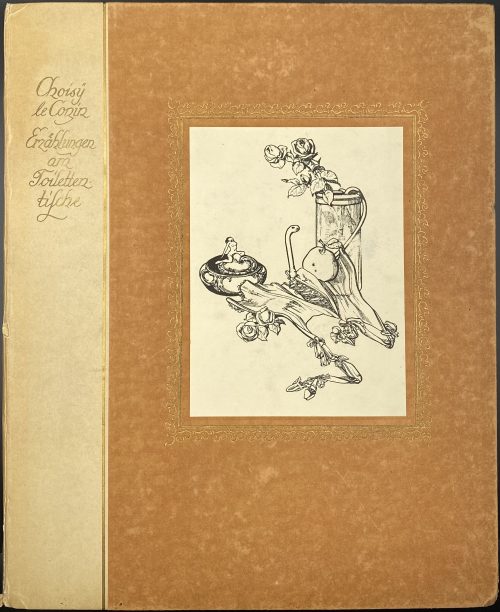 Publisher's flapped portfolio 32.8 x 26.8 cm, gilt-ruled and gilt-lettered quarter faux-parchment waxed paper over brown paper boards with pasted illustration after von Bayros within gilt arabesque frame. Possibly published in Vienna by Heinrich Conrad in 1905 or 1908. The portfolio contains the title page with a vignette and 15 loose wove paper sheets 32 x 26.2 cm of collotype reproductions after drawings by Franz von Bayros. Cover gilt lettering: Choisÿ | le Conin | Erzählungen | am | Toiletten- | tische || Title-page: Erzählungen | am Toilettentische | von | CHOISY LE CONIN | {vignette} || Title-page verso: Inhalt: | 1. Die Tabaksdose | 2. Viola de Gamba | 3. Der Bote | 4. Nicht drängeln, Kinder! | 5. Die blaue Feder | 6. O what a pretty like-place! | 7. Die Sonnenuhr |8. Der Temel der der Cotÿs | 9. Der Fetischist | 10. Jupiter und Europa | 11. Die Witwe | 12. Paroxÿsme-erotique | 13. Der Rivale | 14. Die rote Lehrerin | 15. Tantalus | Nicht im Handel. || Catalogue raisonné: The amorous drawings of the Marquis von Bayros / Part I and II. — NY: Cythera Press, 1968; pp. 95-111 [LIB-2246.2019]
Publisher's flapped portfolio 32.8 x 26.8 cm, gilt-ruled and gilt-lettered quarter faux-parchment waxed paper over brown paper boards with pasted illustration after von Bayros within gilt arabesque frame. Possibly published in Vienna by Heinrich Conrad in 1905 or 1908. The portfolio contains the title page with a vignette and 15 loose wove paper sheets 32 x 26.2 cm of collotype reproductions after drawings by Franz von Bayros. Cover gilt lettering: Choisÿ | le Conin | Erzählungen | am | Toiletten- | tische || Title-page: Erzählungen | am Toilettentische | von | CHOISY LE CONIN | {vignette} || Title-page verso: Inhalt: | 1. Die Tabaksdose | 2. Viola de Gamba | 3. Der Bote | 4. Nicht drängeln, Kinder! | 5. Die blaue Feder | 6. O what a pretty like-place! | 7. Die Sonnenuhr |8. Der Temel der der Cotÿs | 9. Der Fetischist | 10. Jupiter und Europa | 11. Die Witwe | 12. Paroxÿsme-erotique | 13. Der Rivale | 14. Die rote Lehrerin | 15. Tantalus | Nicht im Handel. || Catalogue raisonné: The amorous drawings of the Marquis von Bayros / Part I and II. — NY: Cythera Press, 1968; pp. 95-111 [LIB-2246.2019] -
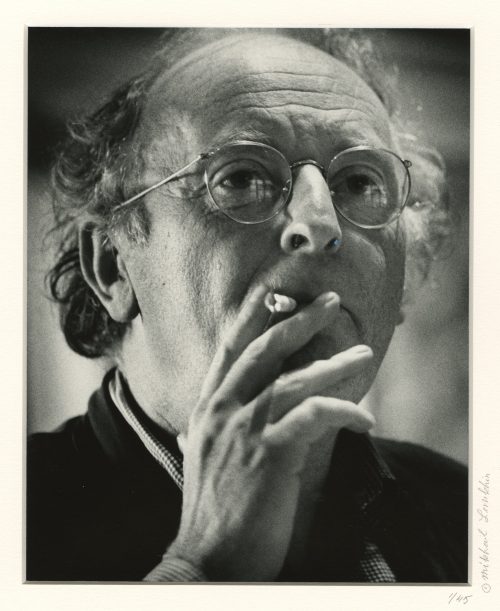 Photographic portrait of poet Joseph Brodsky, head, shoulders, and hand, three-quarters to the right, wearing glasses and with a cigarette. Pencil-signed on the mat: 1/45 • ©Mikhail Lemkhin; same inscription on the back of the print, and ink stamp ©Mikhail Lemkhin. Sitter: Joseph Brodsky [Иосиф Александрович Бродский ] (Russian-American-Jewish, 1940 – 1996). Size: mat: 43 x 35.5 cm; window: 24 x 19 cm.
Photographic portrait of poet Joseph Brodsky, head, shoulders, and hand, three-quarters to the right, wearing glasses and with a cigarette. Pencil-signed on the mat: 1/45 • ©Mikhail Lemkhin; same inscription on the back of the print, and ink stamp ©Mikhail Lemkhin. Sitter: Joseph Brodsky [Иосиф Александрович Бродский ] (Russian-American-Jewish, 1940 – 1996). Size: mat: 43 x 35.5 cm; window: 24 x 19 cm. -
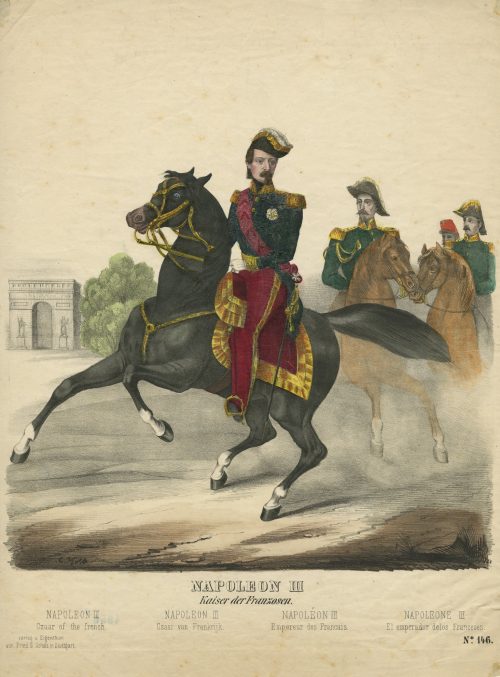 Hand-coloured lithography on wove paper 423 x 332 mm; On reverse: black ink stamp “4956”, ms “A”, ms pencil “428” and “Ernest”. Under the image, centre: "NAPOLEON III | Kaiser der Franzosen." Velow: | NAPOLEON III | Czaar of the French — NAPOLEON III | Czaar van Frankrijk — NAPOLÉON III | Empereur des Francais. — NAPOLEONE III | El emperador delos Franceses; bottom left: "Verlag u. Eigenthum | von. Fried. G. Schulz in Stuttgart.", right: "No 146." The artist's and printer's names in stone are not legible. Published in Stuttgart by Friederich Gustav Schulz (German, 1786 – 1859) during the time of the Second French Empire (1852-1870).
Hand-coloured lithography on wove paper 423 x 332 mm; On reverse: black ink stamp “4956”, ms “A”, ms pencil “428” and “Ernest”. Under the image, centre: "NAPOLEON III | Kaiser der Franzosen." Velow: | NAPOLEON III | Czaar of the French — NAPOLEON III | Czaar van Frankrijk — NAPOLÉON III | Empereur des Francais. — NAPOLEONE III | El emperador delos Franceses; bottom left: "Verlag u. Eigenthum | von. Fried. G. Schulz in Stuttgart.", right: "No 146." The artist's and printer's names in stone are not legible. Published in Stuttgart by Friederich Gustav Schulz (German, 1786 – 1859) during the time of the Second French Empire (1852-1870). -
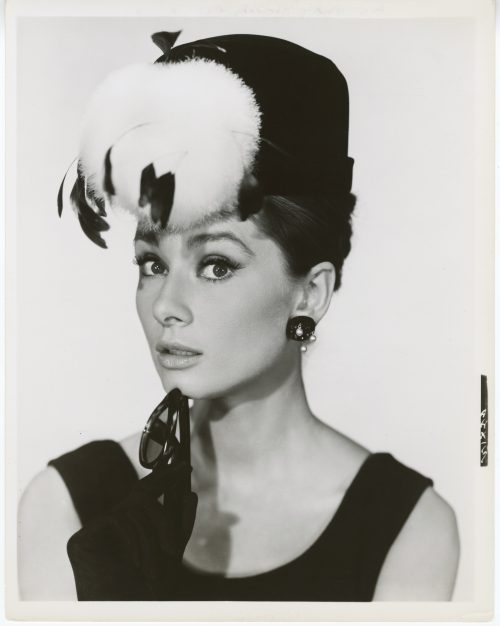 Three-quarter head photographic portrait of British actress Audrey Hepburn, in the American film Breakfast at Tiffany's, shot in 1961 by Paramount Pictures / contemporary gelatin silver print. Inscription to verso (graphite): Audrey Hepburn 1961 | F Breakfast at Tiffany's || Dimensions: 256 x 201 mm. Audrey Hepburn [née Ruston] (British, 1929 – 1993) Paramount Pictures Breakfast at Tiffany's
Three-quarter head photographic portrait of British actress Audrey Hepburn, in the American film Breakfast at Tiffany's, shot in 1961 by Paramount Pictures / contemporary gelatin silver print. Inscription to verso (graphite): Audrey Hepburn 1961 | F Breakfast at Tiffany's || Dimensions: 256 x 201 mm. Audrey Hepburn [née Ruston] (British, 1929 – 1993) Paramount Pictures Breakfast at Tiffany's -
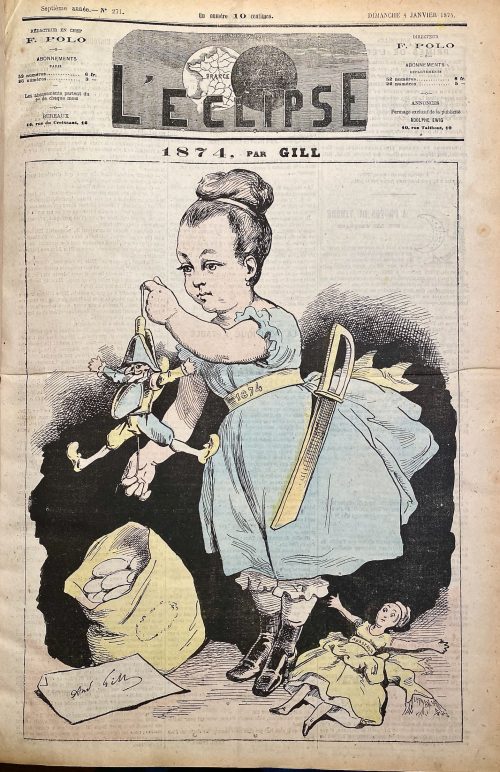 129 issues of L'Éclipse, French weekly political magazine; published in Paris, 49 x 34 cm, bound in rebacked green quarter morocco over marbled boards, with gilt fillets and lettering to spine, peacock marbled endpapers, illustrated by André Gill (French, 1840 – 1885). Founder and editor-in-chief François Polo (French, 1838 – 1874). 1874: 271-322 (52 issues) 1875: 323-374 (52 issues) 1876: 375-399 (25 issues)
129 issues of L'Éclipse, French weekly political magazine; published in Paris, 49 x 34 cm, bound in rebacked green quarter morocco over marbled boards, with gilt fillets and lettering to spine, peacock marbled endpapers, illustrated by André Gill (French, 1840 – 1885). Founder and editor-in-chief François Polo (French, 1838 – 1874). 1874: 271-322 (52 issues) 1875: 323-374 (52 issues) 1876: 375-399 (25 issues) -
 Torii Kiyomitsu II (Kiyomine), Japanese, 1787–1868. Courtesan and her Komura (Doll Festival). Series: Furyu Goyo no Matsu (Customs of 5 Pine Needles, the 5 great festivals). Publisher: Tsuruya Kiemon [Marks: 553].
Torii Kiyomitsu II (Kiyomine), Japanese, 1787–1868. Courtesan and her Komura (Doll Festival). Series: Furyu Goyo no Matsu (Customs of 5 Pine Needles, the 5 great festivals). Publisher: Tsuruya Kiemon [Marks: 553]. -
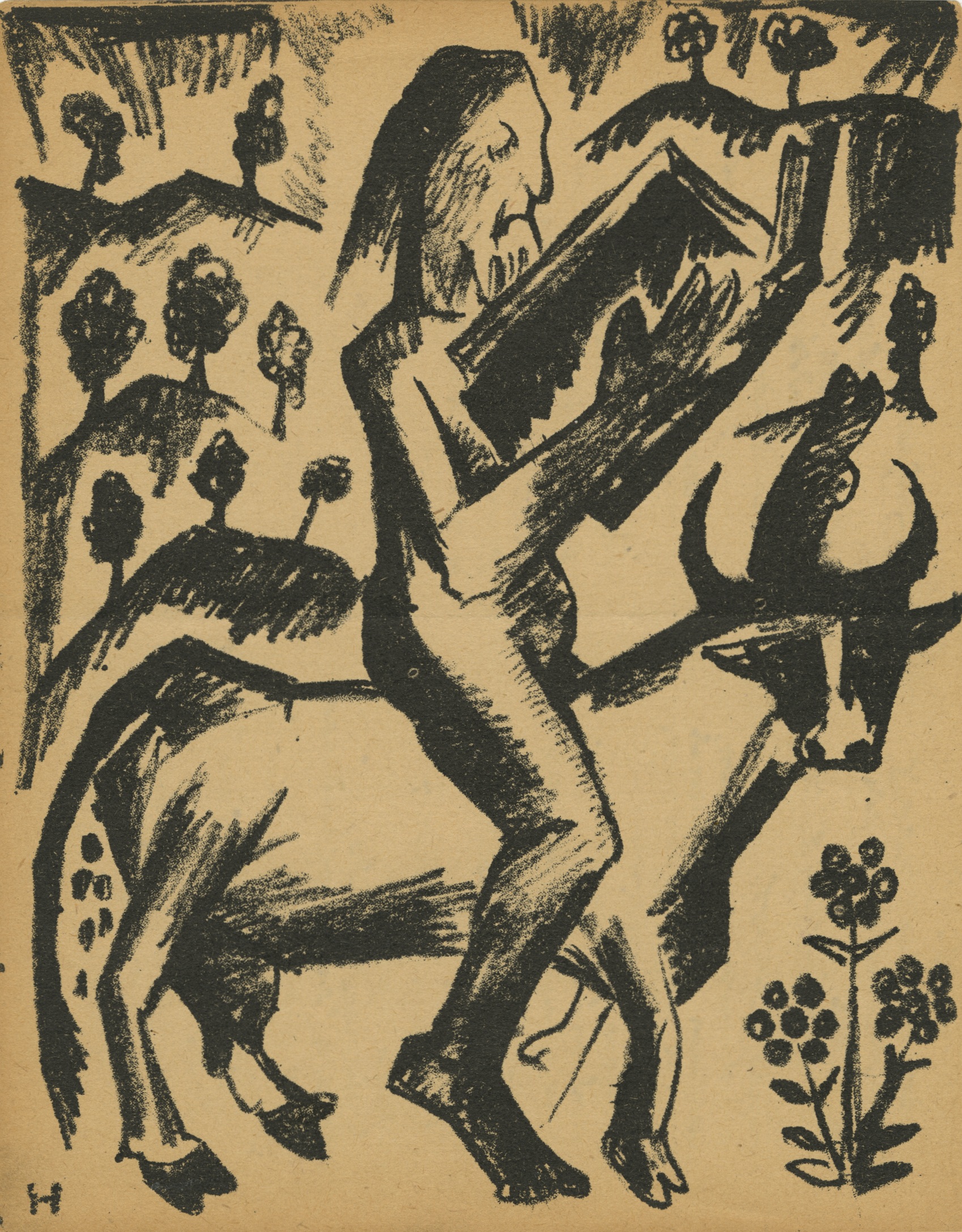 Artist: Natalia Goncharova (July 3, 1881 – October 17, 1962). Russian/French. Lithographic illustration "An elder astride a bull" for Aleksei Kruchenykh book "Two poems. The Hermit. The Hermitess", Moscow, Kuzmin and Dolinsky Publishers, 1913. This sheet is from the book "Natalia Goncharova / Mikhail Larionov" by Eli Eganbyuri (pen-name of Ilia Zdanevich), published by Z. A. Münster in 1913. Inscription on the back: hand-written copy (allegedly by the hand of Osip Brik) of Vladimir Mayakovsky verses for "Red Pepper" (Krasny peretz) magazine issue of 1924, included in the compilation "Ferocious laugh" (Grozny smekh) that was published after Mayakovsky death in 1931. Text of the manuscript on verso. Size: 18,5 х 14,3 cm. Наталия Гончарова (3 июля 1881 – 17 октября 1962). Россия/Франция. Автолитография "Старец верхом на быке" для книги А. Е. Крученых "Две поэмы. Пустынники. Пустынница"; - М.: Изд. Г.Л. Кузьмина, С.Д. Долинского, 1913. Данный лист из книги Эли Эганбюри (псевдоним Ильи Зданевича) "Наталия Гончарова / Михаил Ларионов"; - М. : Изд. Ц. Мюнстера, 1913. На обороте список стихов из подписей к "Красному перцу" 1924 г., которые вошли в сб. "Грозный смех" (вышел после смерти Маяковского в 1931). Вероятно список сделан рукой Осипа Брика. Текст манускрипта. Формат: 18,5 х 14,3 см.
Artist: Natalia Goncharova (July 3, 1881 – October 17, 1962). Russian/French. Lithographic illustration "An elder astride a bull" for Aleksei Kruchenykh book "Two poems. The Hermit. The Hermitess", Moscow, Kuzmin and Dolinsky Publishers, 1913. This sheet is from the book "Natalia Goncharova / Mikhail Larionov" by Eli Eganbyuri (pen-name of Ilia Zdanevich), published by Z. A. Münster in 1913. Inscription on the back: hand-written copy (allegedly by the hand of Osip Brik) of Vladimir Mayakovsky verses for "Red Pepper" (Krasny peretz) magazine issue of 1924, included in the compilation "Ferocious laugh" (Grozny smekh) that was published after Mayakovsky death in 1931. Text of the manuscript on verso. Size: 18,5 х 14,3 cm. Наталия Гончарова (3 июля 1881 – 17 октября 1962). Россия/Франция. Автолитография "Старец верхом на быке" для книги А. Е. Крученых "Две поэмы. Пустынники. Пустынница"; - М.: Изд. Г.Л. Кузьмина, С.Д. Долинского, 1913. Данный лист из книги Эли Эганбюри (псевдоним Ильи Зданевича) "Наталия Гончарова / Михаил Ларионов"; - М. : Изд. Ц. Мюнстера, 1913. На обороте список стихов из подписей к "Красному перцу" 1924 г., которые вошли в сб. "Грозный смех" (вышел после смерти Маяковского в 1931). Вероятно список сделан рукой Осипа Брика. Текст манускрипта. Формат: 18,5 х 14,3 см.Г. Л. Кузьмин и С. Д. Долинский знамениты, в частности, тем, что в 1912 году издали футуристский манифест "Пощечина общественному вкусу". О них можно найти дополнительную информацию в статье об Л. Л. Кузьмине. Издатель Цезарь Александрович Мюнстер был сыном знаменитого русского литографа Александра Эрнестовича Мюнстера, открывшего свое литографическое заведение в Санкт-Петербурге в 1850 году. Судьба Ц. А. Мюнстера и его издательства после революции 1917 года мне неизвестна.
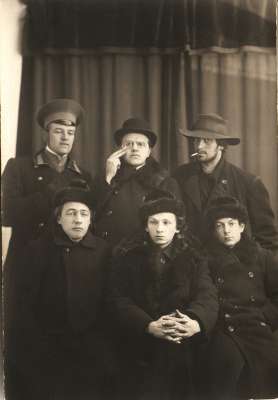
Сидят: В.В. Хлебников, Г.Л. Кузьмин, С.Д. Долинский Стоят: Н.Д. Бурлюк, Д.Д. Бурлюк, В.В. Маяковский. 1911.
-
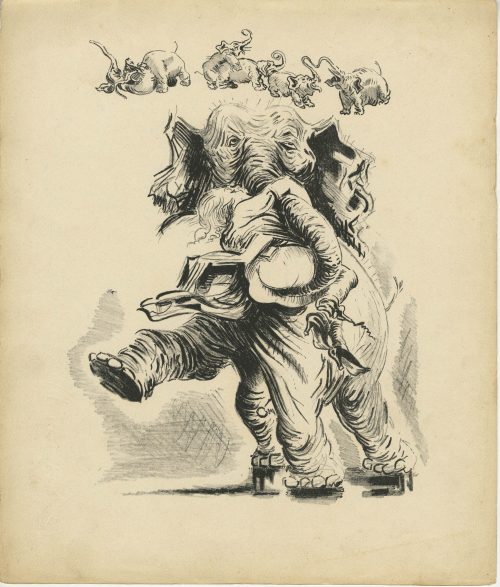
Album of 20 hand-coloured lithographs with a title page and a 'justification du tirage' page in an original snakeskin-clothed cardboard binder. Drawn on stone by Anonymous, attributed to Santippa. The theme of these pictures can be described as erotic humour.
Edition: 200 copies printed in Bruxelles, c. 1938; this copy without a number.
Watermarked wove paper: Word "Marais" and a flower.
Dimensions: 24.3 x 29.3 cm According to J.-P. Dutel, the author of these images is Georges Hoffmann under the pseudonym Santippa. Honesterotica provides a different name: Gaston Hoffmann [Santippa] (French, 1883 – 1977), which seems adequate. Catalogue raisonné: Dutel (1920-70): 2496. -
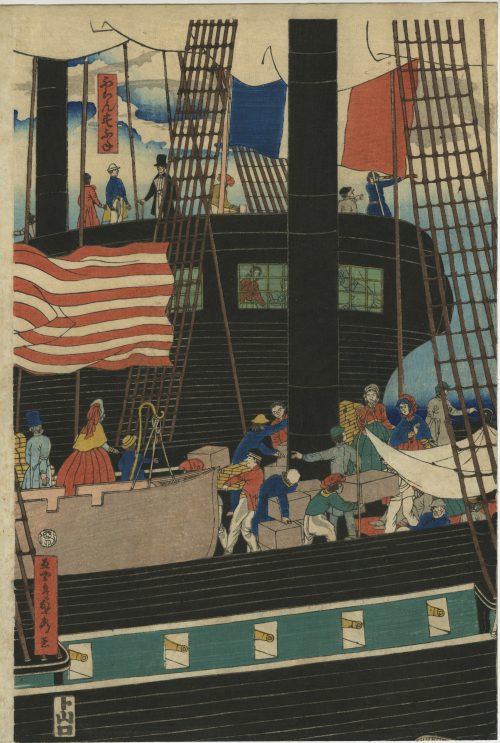 Utagawa Sadahide, a.k.a. Gountei Sadahide (Japanese, 1807 – c. 1878–1879), 五雲亭 貞秀, 歌川 貞秀, Yamaguchiya Tōbei, Yokohama kōeki seiyōjin nimotsu unsō no zu - Western traders loading cargo in Yokohama - 横浜交易西洋人荷物運送之圖, 1861, Woodblock print (nishiki-e); ink and color on paper, Horizontal Ōban Pentaptych: 5 x (37 x 25.5 cm), Alternative title: Picture of Western Traders at Yokohama Transporting Merchandise (Cat. Reisonée: Yokohama ukiyo-e, Yurindo, 1979: №50). Japanese pentaptych print shows an American ship in the harbor at Yokohama, Japan; small boats ferry cargo which is being carried up a gangplank contributing to the bustle of activity on the main deck. April, 1861. SOLD
Utagawa Sadahide, a.k.a. Gountei Sadahide (Japanese, 1807 – c. 1878–1879), 五雲亭 貞秀, 歌川 貞秀, Yamaguchiya Tōbei, Yokohama kōeki seiyōjin nimotsu unsō no zu - Western traders loading cargo in Yokohama - 横浜交易西洋人荷物運送之圖, 1861, Woodblock print (nishiki-e); ink and color on paper, Horizontal Ōban Pentaptych: 5 x (37 x 25.5 cm), Alternative title: Picture of Western Traders at Yokohama Transporting Merchandise (Cat. Reisonée: Yokohama ukiyo-e, Yurindo, 1979: №50). Japanese pentaptych print shows an American ship in the harbor at Yokohama, Japan; small boats ferry cargo which is being carried up a gangplank contributing to the bustle of activity on the main deck. April, 1861. SOLD -
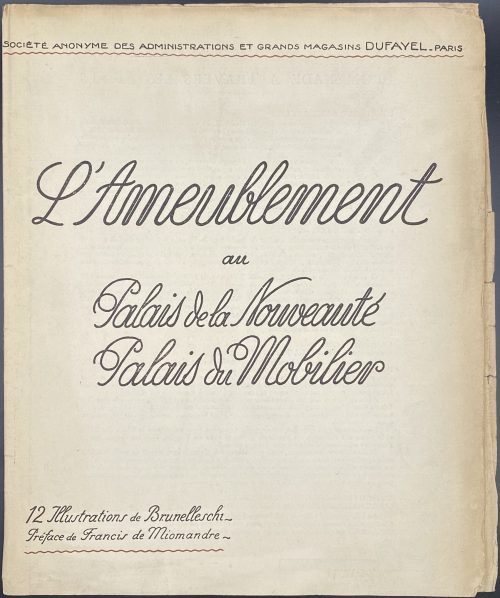 A set of 12 photomechanically reproduced illustrations after gouaches by Umberto Brunelleschi (Italian, 1879 – 1949), in colour; b/w photographs reproductions on verso, in a paper folder without the outer wrappers (b/w with birds, insects, and flowers). Text on the folder by French novelist Francis de Miomandre (French, 1880 – 1959); published by Grands Magasins Dufayel (1856 – 1930), a Parisian department store, run by Georges Dufayel (French, 1855 – 1916). Size: 29 x 24 cm. Images printed on cream paper within a beige frame, lettered above the frame in beige: "Societé Anonyme des Administrations et Grands Magasins DUFAYEL — Paris —", under the frame: "Palais de la Nouveauté ~ Palais du Mobilier | Entrée principale 7 Bould BARBES"; at the bottom of the frame lettered black on each image: Le Style Chinois, Le Style Empire, Le Style Japonais, Le Style Louis XIV, Le Style Louis XV, Le Style Louis XVI, Le Style Moderne (2), Le Style Moyen Age, Le Style Renaissance, Le Style Vénitien, Le Style Persian.
A set of 12 photomechanically reproduced illustrations after gouaches by Umberto Brunelleschi (Italian, 1879 – 1949), in colour; b/w photographs reproductions on verso, in a paper folder without the outer wrappers (b/w with birds, insects, and flowers). Text on the folder by French novelist Francis de Miomandre (French, 1880 – 1959); published by Grands Magasins Dufayel (1856 – 1930), a Parisian department store, run by Georges Dufayel (French, 1855 – 1916). Size: 29 x 24 cm. Images printed on cream paper within a beige frame, lettered above the frame in beige: "Societé Anonyme des Administrations et Grands Magasins DUFAYEL — Paris —", under the frame: "Palais de la Nouveauté ~ Palais du Mobilier | Entrée principale 7 Bould BARBES"; at the bottom of the frame lettered black on each image: Le Style Chinois, Le Style Empire, Le Style Japonais, Le Style Louis XIV, Le Style Louis XV, Le Style Louis XVI, Le Style Moderne (2), Le Style Moyen Age, Le Style Renaissance, Le Style Vénitien, Le Style Persian. -
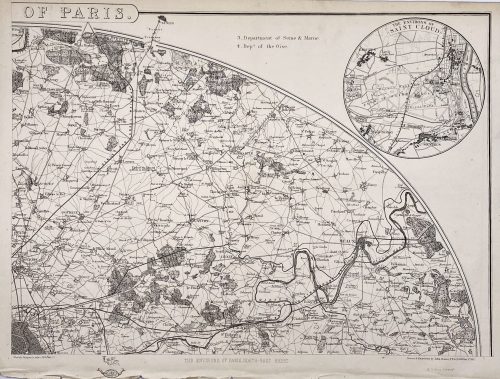 Four maps 34 x 47.5 cm each. Include insets of Versailles, Fontainebleau, Saint Cloud and St. Germain en Laye. Lithograph by Edward Weller after a map drawn and engraved by John Dower. "These maps originally appeared in the Weekly Dispatch newspaper from 1856 to 1862. They were reissued between 1863 and 1867 by Cassell, Petter and Galpin and then published collectively as Cassell's Atlas. The plates were acquired by G.W. Bacon & Co., and reissued in 1876 under the title Bacon's New Quarto Atlas ... of the Counties of England, and many times since under various titles." [WorldCat]
Four maps 34 x 47.5 cm each. Include insets of Versailles, Fontainebleau, Saint Cloud and St. Germain en Laye. Lithograph by Edward Weller after a map drawn and engraved by John Dower. "These maps originally appeared in the Weekly Dispatch newspaper from 1856 to 1862. They were reissued between 1863 and 1867 by Cassell, Petter and Galpin and then published collectively as Cassell's Atlas. The plates were acquired by G.W. Bacon & Co., and reissued in 1876 under the title Bacon's New Quarto Atlas ... of the Counties of England, and many times since under various titles." [WorldCat]Dimensions: 34 x 47.5 cm each.
Contributors: Weller, Edward (British, 1819 – 1884) – lithographer. Dower, John Crane (British, 1791 – 1847) – artist, engraver. Dower, John James (British, 1825 – 1901) – artist, engraver (son of John Crane Dower). -
 The central sheet of (optional) triptych: Courtesan (Tayū): kabuki actor Bandō Mitsugorō III as Fujiya Izaemon from Three pleasures of present-day Osaka (Tōsei Naniwa no sankō)「当世浪花の三興 太夫」 「藤屋伊左衛門」 三代目坂東三津五郎. Publisher: Iseya Rihei [伊勢屋利兵衛] (Japanese, fl. 1790s – c. 1879) Year: 1821 (Bunsei 4). Size: Vertical ōban; 36.5 x 25.1 cm. Signed: 於浮瀬亭国貞画 – Drawn by Kunisada in Ukabuse (Ukabuse ni oite Kunisada ga). Ukabuse is the name of a famous restaurant in Osaka, this signature can be found only on a three print bijin series [Kunisada Project]. Censor's seal: kiwame 改印:極 Actor Bandō Mitsugorō III [三代目 坂東 三津五郎] (Japanese, 1775 – 1831); other names: Bandō Minosuke I, Morita Kanjirô II, Bandō Mitahachi I, Bandō Minosuke I, Bandō Mitahachi I. Character: Fujiya Izaemon. Ref: MFA ACCESSION NUMBER 11.21937; LIB-2967.2022 Izzard. Full series (triptych) Three Pleasures of Present-day Osaka (Tōsei Naniwa no sankō):
The central sheet of (optional) triptych: Courtesan (Tayū): kabuki actor Bandō Mitsugorō III as Fujiya Izaemon from Three pleasures of present-day Osaka (Tōsei Naniwa no sankō)「当世浪花の三興 太夫」 「藤屋伊左衛門」 三代目坂東三津五郎. Publisher: Iseya Rihei [伊勢屋利兵衛] (Japanese, fl. 1790s – c. 1879) Year: 1821 (Bunsei 4). Size: Vertical ōban; 36.5 x 25.1 cm. Signed: 於浮瀬亭国貞画 – Drawn by Kunisada in Ukabuse (Ukabuse ni oite Kunisada ga). Ukabuse is the name of a famous restaurant in Osaka, this signature can be found only on a three print bijin series [Kunisada Project]. Censor's seal: kiwame 改印:極 Actor Bandō Mitsugorō III [三代目 坂東 三津五郎] (Japanese, 1775 – 1831); other names: Bandō Minosuke I, Morita Kanjirô II, Bandō Mitahachi I, Bandō Minosuke I, Bandō Mitahachi I. Character: Fujiya Izaemon. Ref: MFA ACCESSION NUMBER 11.21937; LIB-2967.2022 Izzard. Full series (triptych) Three Pleasures of Present-day Osaka (Tōsei Naniwa no sankō):


-
 Artist: Utagawa Kunisada [歌川 国貞]; a.k.a. Utagawa Toyokuni III [三代歌川豊国] (Japanese, 1786 – 1865). Signed: Toyokuni ga [豊国 画] in a red toshidama cartouche. Publisher: Ibaya Senzaburō [伊場屋仙三郎] (Japanese, fl. C. 1845 – 1847), seal: San [三] (Marks 11-001 | 127c). Block carver: Matsushima Fusajirō [松嶋房次郎] (Japanese, fl. 1843 – 1850); seal [彫工房] – Hori kō Fusa (Gordon Friese № 134). Double nanushi censor seal: Kunigasa & Watanabe (1849-50). Actor: Iwai Hanshirō VIII [岩井半四郎] (Japanese, 1829 – 1882); other names: Iwai Shijaku II, Iwai Kumesaburō III [岩井粂三郎], Iwai Hisajirō II. Play: Yukari no Hana Iro mo Yoshiwara [紫花色吉原], performed at the Kawarazaki Theater (Edo) from the 5th day of the 5th lunar month of Kaei 3 (1850) (see Kabuki Playbill at MFA (Boston) № 11.27996).
Artist: Utagawa Kunisada [歌川 国貞]; a.k.a. Utagawa Toyokuni III [三代歌川豊国] (Japanese, 1786 – 1865). Signed: Toyokuni ga [豊国 画] in a red toshidama cartouche. Publisher: Ibaya Senzaburō [伊場屋仙三郎] (Japanese, fl. C. 1845 – 1847), seal: San [三] (Marks 11-001 | 127c). Block carver: Matsushima Fusajirō [松嶋房次郎] (Japanese, fl. 1843 – 1850); seal [彫工房] – Hori kō Fusa (Gordon Friese № 134). Double nanushi censor seal: Kunigasa & Watanabe (1849-50). Actor: Iwai Hanshirō VIII [岩井半四郎] (Japanese, 1829 – 1882); other names: Iwai Shijaku II, Iwai Kumesaburō III [岩井粂三郎], Iwai Hisajirō II. Play: Yukari no Hana Iro mo Yoshiwara [紫花色吉原], performed at the Kawarazaki Theater (Edo) from the 5th day of the 5th lunar month of Kaei 3 (1850) (see Kabuki Playbill at MFA (Boston) № 11.27996). A famous Yoshiwara courtesan named Manjiya Yatsuhashi [万字屋 八ツ橋] was killed by a provincial commoner Sano Jirōzaemon [佐野次郎左衛門] (on the second sheet of the pair):
A famous Yoshiwara courtesan named Manjiya Yatsuhashi [万字屋 八ツ橋] was killed by a provincial commoner Sano Jirōzaemon [佐野次郎左衛門] (on the second sheet of the pair):
Another Kunisada's print with the same characters in the same play and same performance can be seen at MFA (Boston) № 11.40190.
SVJP-0298.2019: Ichikawa Ebizō V as Sano Jirōzaemon.

SVJP-0297.2019: Iwai Kumesaburō III as Manjiya Yatsuhashi
 One more example can be seen in the two upper images at Waseda University Cultural Resources Database, № 006-2707:
One more example can be seen in the two upper images at Waseda University Cultural Resources Database, № 006-2707:

-
 Artist: Utagawa Kuniyoshi [歌川 國芳] (1798 – 1861). Kabuki actors Ichikawa Danjūrō VIII and Arashi Rikan III as sumo wrestlers Nuregami Chōgorō (L) and Hanaregoma Chōkichi (R), respectively. Signed: Ichiyûsai Kuniyoshi ga (一勇斎 國芳 画) in a double gourd-shaped cartouche with Yoshi Kiri seal. Publisher: No seal. Date seal and double nanushi censor seal: Mera & Watanabe, 1852. Media: Fan print (uchiwa-e, 団扇絵), 231 x 295 mm. Theme: Nine-act drama (11 scenes) Futatsu Chōchō Kuruwa Nikki [双蝶々曲輪日記] (A Diary of Two Butterflies in the Pleasure Quarters) written by Takeda Izumo II, Namiki Senryū I, Miyoshi Shōraku (7/1749) as puppet play Bunraku [文楽], adopted for Kabuki theatre by Arashi San'emon IV. “The sumo wrestler Nuregami Chōgorō is trying to ransom the courtesan Azuma for Yogoro, in whose debt he stands. Hiraoka Goemon, who is at odds with Yogorō and Azuma, is the patron of the amateur wrestler Hanaregoma Chōkichi. Chōgorō purposely loses to Chōkichi and then asks the latter to stop Goemon's ransoming of Azuma; Chōkichi refuses, however, and they quarrel. Admonished for his dissipation by his sister Oseki, Chōkichi is going to commit ritual suicide (seppuku) as an apology for his behavior, but Chōgorō, who happens along just then, prevents him. The two men swear blood brotherhood. […] The confrontation between Chōgorō and Chōkichi in the Sumōba scene, acted in the exaggerated style called aragoto, is a major highlight of the work. The scene in Yohei's home, known as Hikimado, presents the unfolding of Kabuki's eternal conflict between duty and feelings, here represented by the act of opening the skylight (hikimado) to which Chōgorō is tied”. [Samuel L. Leiter. Kabuki Encyclopedia: an English-language adaptation of Kabuki Jiten. — Westport, CT; London: Greenwood Press, 1979, pp. 70-71]. See also James R. Brandon and Samuel L. Leiter. Kabuki plays on stage, vol. 1, pp. 234-258. — Honolulu: University of Hawai'i Press, 2002. Actors: Ichikawa Danjūrō VIII [市川団十郎] (Japanese, 1823 – 1854); other names: Ichikawa Ebizō VI, Ichikawa Shinnosuke II. Arashi Rikan III [嵐璃寛] (Japanese, 1812 – 1863); other names Arashi Tokusaburō III, Arashi Kicchō I, Onoe Wasaburō I. Another print in this collection with the same theme: SVJP-0331.2020.
Artist: Utagawa Kuniyoshi [歌川 國芳] (1798 – 1861). Kabuki actors Ichikawa Danjūrō VIII and Arashi Rikan III as sumo wrestlers Nuregami Chōgorō (L) and Hanaregoma Chōkichi (R), respectively. Signed: Ichiyûsai Kuniyoshi ga (一勇斎 國芳 画) in a double gourd-shaped cartouche with Yoshi Kiri seal. Publisher: No seal. Date seal and double nanushi censor seal: Mera & Watanabe, 1852. Media: Fan print (uchiwa-e, 団扇絵), 231 x 295 mm. Theme: Nine-act drama (11 scenes) Futatsu Chōchō Kuruwa Nikki [双蝶々曲輪日記] (A Diary of Two Butterflies in the Pleasure Quarters) written by Takeda Izumo II, Namiki Senryū I, Miyoshi Shōraku (7/1749) as puppet play Bunraku [文楽], adopted for Kabuki theatre by Arashi San'emon IV. “The sumo wrestler Nuregami Chōgorō is trying to ransom the courtesan Azuma for Yogoro, in whose debt he stands. Hiraoka Goemon, who is at odds with Yogorō and Azuma, is the patron of the amateur wrestler Hanaregoma Chōkichi. Chōgorō purposely loses to Chōkichi and then asks the latter to stop Goemon's ransoming of Azuma; Chōkichi refuses, however, and they quarrel. Admonished for his dissipation by his sister Oseki, Chōkichi is going to commit ritual suicide (seppuku) as an apology for his behavior, but Chōgorō, who happens along just then, prevents him. The two men swear blood brotherhood. […] The confrontation between Chōgorō and Chōkichi in the Sumōba scene, acted in the exaggerated style called aragoto, is a major highlight of the work. The scene in Yohei's home, known as Hikimado, presents the unfolding of Kabuki's eternal conflict between duty and feelings, here represented by the act of opening the skylight (hikimado) to which Chōgorō is tied”. [Samuel L. Leiter. Kabuki Encyclopedia: an English-language adaptation of Kabuki Jiten. — Westport, CT; London: Greenwood Press, 1979, pp. 70-71]. See also James R. Brandon and Samuel L. Leiter. Kabuki plays on stage, vol. 1, pp. 234-258. — Honolulu: University of Hawai'i Press, 2002. Actors: Ichikawa Danjūrō VIII [市川団十郎] (Japanese, 1823 – 1854); other names: Ichikawa Ebizō VI, Ichikawa Shinnosuke II. Arashi Rikan III [嵐璃寛] (Japanese, 1812 – 1863); other names Arashi Tokusaburō III, Arashi Kicchō I, Onoe Wasaburō I. Another print in this collection with the same theme: SVJP-0331.2020. Reference images:
Reference images:
-
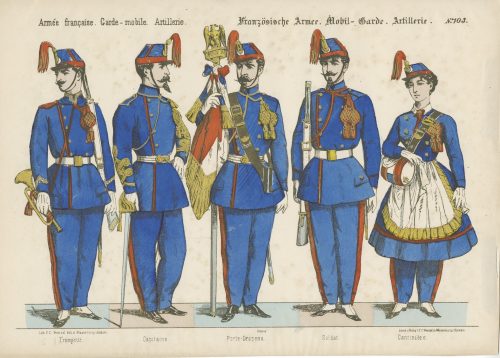 Hand-coloured woodcut on wove paper, 282 x 392 mm; black ink stamp “5051 2” to reverse. Top: "Armée française. Garde–mobile. Artillerie." — (gothic font) "Französische Armee. Mobil–Garde. Artillerie." — "№103". Below left: "Lith F. C. Wentzel édit. à Wissembourg. (Alsacé); center: Déposé; right: Druck u. Verlag v. F. C. Wentzel in Weissemburg. (Elsass)."; Bottom: "Trompette" — "Capitaine" — "Porte-Drapeau". — "Soldat" — "Cantinière." Jean Frédéric Wentzel (French, 1807 – 1869) – publisher/printer.
Hand-coloured woodcut on wove paper, 282 x 392 mm; black ink stamp “5051 2” to reverse. Top: "Armée française. Garde–mobile. Artillerie." — (gothic font) "Französische Armee. Mobil–Garde. Artillerie." — "№103". Below left: "Lith F. C. Wentzel édit. à Wissembourg. (Alsacé); center: Déposé; right: Druck u. Verlag v. F. C. Wentzel in Weissemburg. (Elsass)."; Bottom: "Trompette" — "Capitaine" — "Porte-Drapeau". — "Soldat" — "Cantinière." Jean Frédéric Wentzel (French, 1807 – 1869) – publisher/printer. -
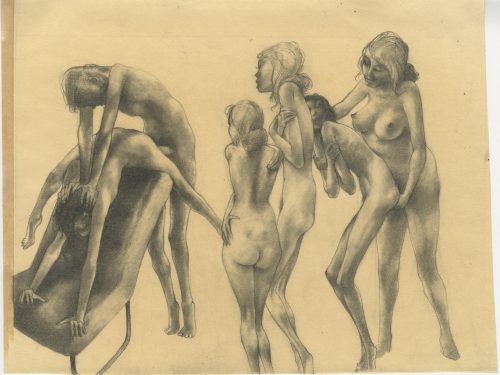 Graphite on wove paper, 217 x 284 mm, black ink stamp to verso: “Prof O. R. Schatz | Wien II, Gr. Mohreng 3b | Tel.: 55 82 566”. Unsigned, attributed to Otto Rudolf Schatz (Austrian, 1900 – 1961).
Graphite on wove paper, 217 x 284 mm, black ink stamp to verso: “Prof O. R. Schatz | Wien II, Gr. Mohreng 3b | Tel.: 55 82 566”. Unsigned, attributed to Otto Rudolf Schatz (Austrian, 1900 – 1961). -
 L'incendie de Hôtel de Ville (24 mai 1871). A woodcut by Provost; printed by Imp. Charaire et fils; F. Roy, éditier.
L'incendie de Hôtel de Ville (24 mai 1871). A woodcut by Provost; printed by Imp. Charaire et fils; F. Roy, éditier. -
 Torii Kiyonaga (鳥居 清長; 1752 – June 28, 1815) Signed: Kiyonaga ga (清長画)
Torii Kiyonaga (鳥居 清長; 1752 – June 28, 1815) Signed: Kiyonaga ga (清長画)References: No references whatsoever, not in Pins.
-
 Utagawa Kunisada (Japanese: 歌川 国貞; also known as Utagawa Toyokuni III (三代歌川豊国); 1786 – 12 January 1865).
Utagawa Kunisada (Japanese: 歌川 国貞; also known as Utagawa Toyokuni III (三代歌川豊国); 1786 – 12 January 1865).A man with a shaved head (a monk), holding a paper lantern and an umbrella, walks with a young woman (a geisha) in the rain.
SIGNED: Gototei Kunisada ga [五渡亭国貞画]
Censor's seals: kiwame, futakata.
Blockcutter's mark: Seizô tô [改印:極、貳方]
MFA ACCESSION NUMBER 11.15150; MFA dating: about 1815–21 (Bunka 12–Bunsei 4);
Size: Vertical Ōban (382 x 260 mm). SOLD -
 Uncut fan print (uchiwa-e) with the design of kabuki actor Nakamura Utaemon IV who held the name of Nakamura Shikan II from the 11th lunar month of 1825 to the 12th lunar month of 1835, dressed in a checkered kimono, holding a pipe and surrounded by flying fireflies. Character: Nakamura Utaemon IV [中村歌右衛門] (Japanese, 1796 – 1852); other names: Nakamura Shikan II, Nakamura Tsurusuke I, Nakamura Tōtarō. Series title: Catching fireflies in the floating world [浮世蛍狩] (Ukiyo hotarugari). Artist: Utagawa Kunisada [歌川 国貞], a.k.a. Toyokuni III (Japanese, 1786 – 1865). Signed: Kōchōrō Kunisada ga [香蝶楼国貞画] in a red cartouche. Publisher: Ibaya Kyubei [伊場屋 久兵衛] (Japanese, fl. 1804 – 1851); seal: modified Marks 19-009 | 126d. Censor's seal: Kiwame Date seal: Tenpō 2 (1831). Ref: Kunisada.de, N58. A look-alike yearlier Kunisada's design can be found at kunisada.de, ref. # N120-Z0172-410:
Uncut fan print (uchiwa-e) with the design of kabuki actor Nakamura Utaemon IV who held the name of Nakamura Shikan II from the 11th lunar month of 1825 to the 12th lunar month of 1835, dressed in a checkered kimono, holding a pipe and surrounded by flying fireflies. Character: Nakamura Utaemon IV [中村歌右衛門] (Japanese, 1796 – 1852); other names: Nakamura Shikan II, Nakamura Tsurusuke I, Nakamura Tōtarō. Series title: Catching fireflies in the floating world [浮世蛍狩] (Ukiyo hotarugari). Artist: Utagawa Kunisada [歌川 国貞], a.k.a. Toyokuni III (Japanese, 1786 – 1865). Signed: Kōchōrō Kunisada ga [香蝶楼国貞画] in a red cartouche. Publisher: Ibaya Kyubei [伊場屋 久兵衛] (Japanese, fl. 1804 – 1851); seal: modified Marks 19-009 | 126d. Censor's seal: Kiwame Date seal: Tenpō 2 (1831). Ref: Kunisada.de, N58. A look-alike yearlier Kunisada's design can be found at kunisada.de, ref. # N120-Z0172-410:
Actor Onoe Baikō, artist Kunisada, publisher Ibaya Kyūbei, c. 1820.
-
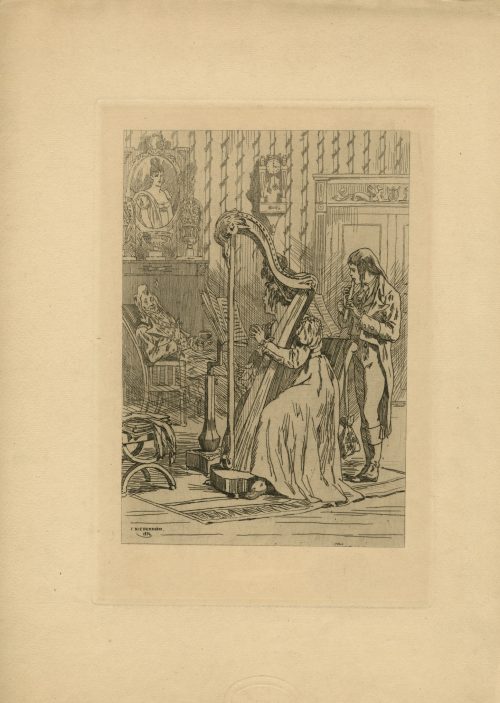
Two prints on laid paper, one in an earlier state, published under the name Niederkorn. Owner's stamp 'LvM' on verso.
Dimensions: Paper (1): 31 x 22.3 cm; Paper (2): 46 x 33.8 cm; Plate: 31 x 22 cm; Image: 25.5 x 17.5 cm.
Catalogue raisonné: Arthur Hubschmid (1977): 318; Rouir 954:3 and 954:5?.
-
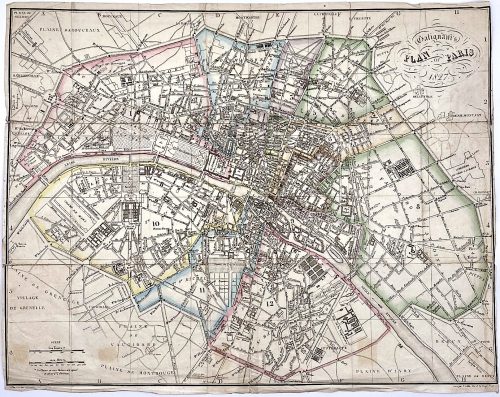 Upper right: Galignani's | PLAN OF PARIS | 1827 || in oval frame: Sauve sculpt. Bottom, under the frame: le Plan écrit par Lallemand. […] Gravé par E. Collin. Rue de la Harpe № 45. Dimensions: 36.5 x 46.5 cm. Armand Joseph Lallemand (French, c. 1810 - 1871) – cartographer. Charles-Étienne Collin (French, 1770 – 1840) – engraver. Étienne Collin II (French,1790 – 1852) – engraver. John Anthony Galignani (Italian, 1796 – 1873) – publisher. William Galignani (Italian, 1798 – 1882) – publisher.
Upper right: Galignani's | PLAN OF PARIS | 1827 || in oval frame: Sauve sculpt. Bottom, under the frame: le Plan écrit par Lallemand. […] Gravé par E. Collin. Rue de la Harpe № 45. Dimensions: 36.5 x 46.5 cm. Armand Joseph Lallemand (French, c. 1810 - 1871) – cartographer. Charles-Étienne Collin (French, 1770 – 1840) – engraver. Étienne Collin II (French,1790 – 1852) – engraver. John Anthony Galignani (Italian, 1796 – 1873) – publisher. William Galignani (Italian, 1798 – 1882) – publisher. -
 Artist: Utagawa Kunisada [歌川 国貞] a.k.a. Utagawa Toyokuni III [三代歌川豊国] (Japanese, 1786 – 1865). Signed: Kunisada ga [国貞画] in a red double-gourd cartouche. Publisher: Iseya Sōemon [伊勢屋惣右衛門] (Japanese, c. 1776 – 1862). Date seal and kiwame censor seal: 1840 (Tenpō 11). Media: Untrimmed fan print (uchiwa-e), 227 x 293 mm. Title: Benzaiten Shrine at Honjō Block One [ひとつ目乃弁天] (Hitotsume no Benten). Provenance: The Collection of Paul F. Walter, Christie's, New York, 2017, lot 341; sold together with 5 other fan prints for $25,000. Before: Christie's, New York, 1997, lot 93 ($5,520). Ref: [LIB-1693.2018] The Collection of Paul Walter. — NY: Christie's, 2017, p. 363. Ref: Israel Goldman, Catalogue 2018, № 31: "Utagawa Kunisada (1786-1865) A Woman Reading a Letter by the Light of a Lantern. Hitotsume no Benten (One-eyed Benten). 1840. Fan print. Provenance: Japanese Prints, Paintings and Screens, Christie's, New York, 1997, lot 93 ($5,520), The Collection of Paul F. Walter, Christie's, New York, 2017, lot 341. Fine impression and colour. Expertly restored wormholes in the lower margin." Markus Sesko comment regarding the series title: "Some time between in the latter half of the 17th century, blind acupuncturist Sugiyama Waichi (1614–1694) cured a neurotic disease afflicting Shōgun Tokugawa Tsunayoshi. Tsunayoshi asked Sugiyama what he would like as a reward, he answered that all that he would really desire was just one functioning eye. Now here we arrive at a wordplay. “One eye,” as you know, is Hitotsu-me in Japanese. As Tsunayoshi obviously could not reward Sugiyama with an eye, he gave him the entire first block of the Honjō neighbourhood in Edo, measuring about 1.2 ha. So, Honjō Block One is Honjō Hitotsu-me in Japanese as me not only means “eye,” but also “number.” Sugiyama moved there, but as he was praying to Benzaiten enshrined in the Enoshima-jinja southwest of Kamakura, Tsunayoshi gave Sugiyama permission to erect a small shrine on his new premises that was then dedicated to Benzaiten as well. To spare the old blind man the long trip so to speak. This shrine was named Honjō Hitotsu-me Benzaiten Shrine, short Hitotsu-me Benten, meaning the “Benzaiten Shrine at Honjō Block One.” That is, the label in the print refers to this context, i.e., location, not to a one-eyed Benzaiten. Sugiyama also had some rock formations of the “original” Benzaiten Shrine at Enoshima copied at his place, which was named Iwaya (い王や) (see picture attached). The lantern the woman is holding in the print is inscribed “Imuya” (い無や). Usually, the character mu (無) is not read wa in replacing a syllable, so maybe Imuya can be attributed to artistic freedom on part of Utagawa Kunisada, referring to the local Iwaya garden?"
Artist: Utagawa Kunisada [歌川 国貞] a.k.a. Utagawa Toyokuni III [三代歌川豊国] (Japanese, 1786 – 1865). Signed: Kunisada ga [国貞画] in a red double-gourd cartouche. Publisher: Iseya Sōemon [伊勢屋惣右衛門] (Japanese, c. 1776 – 1862). Date seal and kiwame censor seal: 1840 (Tenpō 11). Media: Untrimmed fan print (uchiwa-e), 227 x 293 mm. Title: Benzaiten Shrine at Honjō Block One [ひとつ目乃弁天] (Hitotsume no Benten). Provenance: The Collection of Paul F. Walter, Christie's, New York, 2017, lot 341; sold together with 5 other fan prints for $25,000. Before: Christie's, New York, 1997, lot 93 ($5,520). Ref: [LIB-1693.2018] The Collection of Paul Walter. — NY: Christie's, 2017, p. 363. Ref: Israel Goldman, Catalogue 2018, № 31: "Utagawa Kunisada (1786-1865) A Woman Reading a Letter by the Light of a Lantern. Hitotsume no Benten (One-eyed Benten). 1840. Fan print. Provenance: Japanese Prints, Paintings and Screens, Christie's, New York, 1997, lot 93 ($5,520), The Collection of Paul F. Walter, Christie's, New York, 2017, lot 341. Fine impression and colour. Expertly restored wormholes in the lower margin." Markus Sesko comment regarding the series title: "Some time between in the latter half of the 17th century, blind acupuncturist Sugiyama Waichi (1614–1694) cured a neurotic disease afflicting Shōgun Tokugawa Tsunayoshi. Tsunayoshi asked Sugiyama what he would like as a reward, he answered that all that he would really desire was just one functioning eye. Now here we arrive at a wordplay. “One eye,” as you know, is Hitotsu-me in Japanese. As Tsunayoshi obviously could not reward Sugiyama with an eye, he gave him the entire first block of the Honjō neighbourhood in Edo, measuring about 1.2 ha. So, Honjō Block One is Honjō Hitotsu-me in Japanese as me not only means “eye,” but also “number.” Sugiyama moved there, but as he was praying to Benzaiten enshrined in the Enoshima-jinja southwest of Kamakura, Tsunayoshi gave Sugiyama permission to erect a small shrine on his new premises that was then dedicated to Benzaiten as well. To spare the old blind man the long trip so to speak. This shrine was named Honjō Hitotsu-me Benzaiten Shrine, short Hitotsu-me Benten, meaning the “Benzaiten Shrine at Honjō Block One.” That is, the label in the print refers to this context, i.e., location, not to a one-eyed Benzaiten. Sugiyama also had some rock formations of the “original” Benzaiten Shrine at Enoshima copied at his place, which was named Iwaya (い王や) (see picture attached). The lantern the woman is holding in the print is inscribed “Imuya” (い無や). Usually, the character mu (無) is not read wa in replacing a syllable, so maybe Imuya can be attributed to artistic freedom on part of Utagawa Kunisada, referring to the local Iwaya garden?" -
 Title: Early Spring [初春之図] (Hatsuharu no zu); Series: Fashionable Twelve Months [今様十二ヶ月] (Imayo juni-kagetsu). Another version of translation: Modern Beauties of Twelve Months. Artist: Utagawa Toyokuni I [歌川豊国] (1769–1825). Pubisher: Ibaya Senzaburō [伊場屋仙三郎] (Japanese, 1815 – 1869), seal: Dansendō [伊場仙]. Signed: Toyokuni ga [豊国画] and sealed with toshidama. Date-kiwame seal: Ushi (ox), Bunsei 5 (1822). Size: double-sheet uncut fan print ( aiban uchiwa-e), each 217 x 288 mm. Ref: Tokyo Museum Collection.
Title: Early Spring [初春之図] (Hatsuharu no zu); Series: Fashionable Twelve Months [今様十二ヶ月] (Imayo juni-kagetsu). Another version of translation: Modern Beauties of Twelve Months. Artist: Utagawa Toyokuni I [歌川豊国] (1769–1825). Pubisher: Ibaya Senzaburō [伊場屋仙三郎] (Japanese, 1815 – 1869), seal: Dansendō [伊場仙]. Signed: Toyokuni ga [豊国画] and sealed with toshidama. Date-kiwame seal: Ushi (ox), Bunsei 5 (1822). Size: double-sheet uncut fan print ( aiban uchiwa-e), each 217 x 288 mm. Ref: Tokyo Museum Collection.
Other five prints of this series: SVJP 0326.2020; SVJP-0362.2022; SVJP-0363.2022; SVJP-0364.2022; SVJP-0365.2022.

-
 Artist: Utagawa Kunisada [歌川 国貞], a.k.a. Utagawa Toyokuni III [三代 歌川 豊国] (Japanese, 1786 – 1865). Signed: Toyokuni ga [豊国 画] in a red toshidama cartouche Publisher: Iseya Ichiemon [伊勢屋市右衛門] (Japanese, fl. c. 1820s – c. 1860s); seal Tsuji [辻] (Marks 16-029). Media: Untrimmed fan print (uchiwa-e), 225 x 295 mm, plus 10 mm paper strip glued on top (235 mm total height). Title: Plucking Popular Songs in Those Days [時世葉歌の爪弾] (Imayo ha-uta no tsuma-biki). Date seal and aratame seal: Ansei 3 (1856). Seller's Description: Uchiwa-e; picture intended for a summer fan. Here we see a relaxed beauty wearing loose layers of kimono and playing her shamisen instrument. She appears to be in the happy mood of spring, her singing inspired by the cherry blossoms in full bloom that we see outside of her window. She enjoys leisurely plucking with the plectrum of the shamisen and singing “ha-uta” (popular) songs. The title Ha-uta [葉歌] is normally written 端歌, which indicates a certain category of popular songs accompanied by shamisen with short texts that are drawn from daily life. Here however, the title葉歌 uses phonetically the same “ha葉“, referring to the title of the book of a collection of ha-uta songs, Matsu no ha [松の], which was published in five volumes in 1703 by Shûshôken 秀松軒. It is said that this collection of songs was written and sung by the blind (who were often musicians by livelihood). Behind her, lying on the window sill, we see two ha-uta songbooks, one open and one closed. The last half of the title tsuma-biki [爪弾] translates “to pluck with fingers” instead of a plectrum, which is the usual way of playing the shamisen.
Artist: Utagawa Kunisada [歌川 国貞], a.k.a. Utagawa Toyokuni III [三代 歌川 豊国] (Japanese, 1786 – 1865). Signed: Toyokuni ga [豊国 画] in a red toshidama cartouche Publisher: Iseya Ichiemon [伊勢屋市右衛門] (Japanese, fl. c. 1820s – c. 1860s); seal Tsuji [辻] (Marks 16-029). Media: Untrimmed fan print (uchiwa-e), 225 x 295 mm, plus 10 mm paper strip glued on top (235 mm total height). Title: Plucking Popular Songs in Those Days [時世葉歌の爪弾] (Imayo ha-uta no tsuma-biki). Date seal and aratame seal: Ansei 3 (1856). Seller's Description: Uchiwa-e; picture intended for a summer fan. Here we see a relaxed beauty wearing loose layers of kimono and playing her shamisen instrument. She appears to be in the happy mood of spring, her singing inspired by the cherry blossoms in full bloom that we see outside of her window. She enjoys leisurely plucking with the plectrum of the shamisen and singing “ha-uta” (popular) songs. The title Ha-uta [葉歌] is normally written 端歌, which indicates a certain category of popular songs accompanied by shamisen with short texts that are drawn from daily life. Here however, the title葉歌 uses phonetically the same “ha葉“, referring to the title of the book of a collection of ha-uta songs, Matsu no ha [松の], which was published in five volumes in 1703 by Shûshôken 秀松軒. It is said that this collection of songs was written and sung by the blind (who were often musicians by livelihood). Behind her, lying on the window sill, we see two ha-uta songbooks, one open and one closed. The last half of the title tsuma-biki [爪弾] translates “to pluck with fingers” instead of a plectrum, which is the usual way of playing the shamisen. -
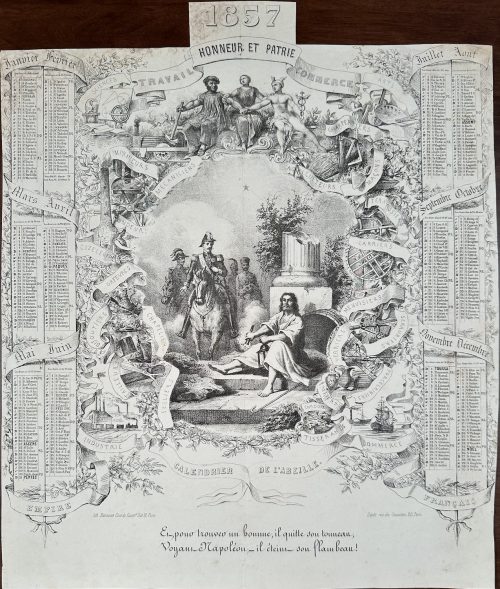 Lithography and etching on wove paper432 x 362 mm, black ink stamp “5022” to reverse, horizontal and vertical centrefolds. Depicts Diogenes (Ancient Greek, 412/404 – 323 BC) beside his barrel and extinguishing his torch when approached by Napoléon III ahorseback. Top: "1857 | HONNEUR ET PATRIE"; lettering on ribbons (top-down): SCIENCES, TRAVAIL, COMMERCE, ARTS, CHARPENTIERS, IMPRIMEURS, "MECHANICIENS, AGRICULTEURS, MAÇONS, FONDEURS, TERRASIERS, CIZELEURS, CARRIERS, ORFEVRES, BIJOUTIERS, CHAPELIERS, MENUISIERS, VERRIERS, SERRURIERS, TAILLEURS, SELLIERS, POTIERS, PORCELAINIERS, CORDONNIERS, TISSERANDS, INDUSTRIE, COMMERCE | CALENDRIER DE L'ABEILLE | EMPIRE, FRANÇAIS. Below left: "lith. Barousse Cour du Comm. 11 et 12. Paris"; right: "Dépôt rue des Cannettes, 20. Paris"; bottom: "Et, pour trouver un homme, il quitte son tonneau, | Voyant Napoléon, – il éteint son flambeau!" [And, to find a man, he leaves his barrel, | Seeing Napoleon, – he extinguishes his torch!]. Six months on the left and six months on the right-hand side of the calendar, surrounding the image.
Lithography and etching on wove paper432 x 362 mm, black ink stamp “5022” to reverse, horizontal and vertical centrefolds. Depicts Diogenes (Ancient Greek, 412/404 – 323 BC) beside his barrel and extinguishing his torch when approached by Napoléon III ahorseback. Top: "1857 | HONNEUR ET PATRIE"; lettering on ribbons (top-down): SCIENCES, TRAVAIL, COMMERCE, ARTS, CHARPENTIERS, IMPRIMEURS, "MECHANICIENS, AGRICULTEURS, MAÇONS, FONDEURS, TERRASIERS, CIZELEURS, CARRIERS, ORFEVRES, BIJOUTIERS, CHAPELIERS, MENUISIERS, VERRIERS, SERRURIERS, TAILLEURS, SELLIERS, POTIERS, PORCELAINIERS, CORDONNIERS, TISSERANDS, INDUSTRIE, COMMERCE | CALENDRIER DE L'ABEILLE | EMPIRE, FRANÇAIS. Below left: "lith. Barousse Cour du Comm. 11 et 12. Paris"; right: "Dépôt rue des Cannettes, 20. Paris"; bottom: "Et, pour trouver un homme, il quitte son tonneau, | Voyant Napoléon, – il éteint son flambeau!" [And, to find a man, he leaves his barrel, | Seeing Napoleon, – he extinguishes his torch!]. Six months on the left and six months on the right-hand side of the calendar, surrounding the image. -
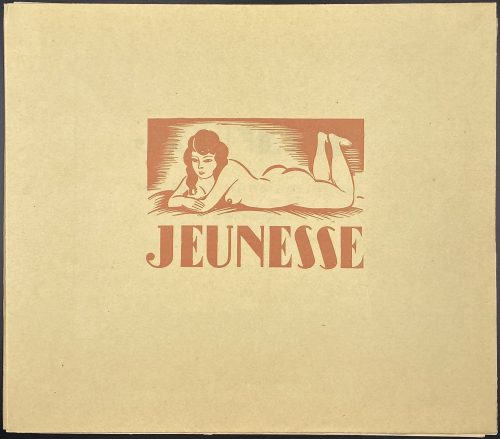 12 hand-coloured soft-ground etchings by André Collot, unbound, in a paper folder with pink lettering and vignette engraved on wood, with a title-page in black: JEUNESSE | 12 VERNIS MOUS COLORIÉS | tires à exemplaires | réservés aux Amis de l’Artiste | 1933 ||, in a frame. Edition: 1st edition, limited to 60 copies. Catalogue raisonné: Dutel 1920-70: 1786.
12 hand-coloured soft-ground etchings by André Collot, unbound, in a paper folder with pink lettering and vignette engraved on wood, with a title-page in black: JEUNESSE | 12 VERNIS MOUS COLORIÉS | tires à exemplaires | réservés aux Amis de l’Artiste | 1933 ||, in a frame. Edition: 1st edition, limited to 60 copies. Catalogue raisonné: Dutel 1920-70: 1786. -
 Seiro ehon nenju gyoji 青楼絵本年中行事 (A Picture Book of Annual Events in Yoshiwara). Block cut by: Fuji Kazumune (藤一宗). Printed by: Jakushodo Toemon (霍松堂藤右衛門). Written by: Jippensha Ikku (十返舎一九) (text, kyoka 4 & 12). Published by: Kazusaya Chusuke (上総屋忠助). Print artist: Kitagawa Utamaro (喜多川歌麿). Written by: Sandara Boshi (三陀羅法師) (kyoka 1). Workshop of: Yashiki no Katamaru (屋職堅丸). 1804 (spring); Edo. Reference: British Museum; Fine Arts Museums of San Francisco.
Seiro ehon nenju gyoji 青楼絵本年中行事 (A Picture Book of Annual Events in Yoshiwara). Block cut by: Fuji Kazumune (藤一宗). Printed by: Jakushodo Toemon (霍松堂藤右衛門). Written by: Jippensha Ikku (十返舎一九) (text, kyoka 4 & 12). Published by: Kazusaya Chusuke (上総屋忠助). Print artist: Kitagawa Utamaro (喜多川歌麿). Written by: Sandara Boshi (三陀羅法師) (kyoka 1). Workshop of: Yashiki no Katamaru (屋職堅丸). 1804 (spring); Edo. Reference: British Museum; Fine Arts Museums of San Francisco. -
 Similar image at MFA under title: Actors and Women in the Snow MFA ACCESSION NUMBER: 11.13568 Date: 1809 (Bunka 6), 12th month Artist: Utagawa Toyokuni I (1769–1825) Publisher Tsuruya Kinsuke (firm name Sôkakudô), № 554 in Marks's "Publishers". DIMENSIONS: Vertical ôban; 38.2 x 25.8 cm (15 1/16 x 10 3/16 in.) MEDIUM OR TECHNIQUE: Woodblock print (nishiki-e); ink and color on paper. Signed: Toyokuni ga (豊国画) Censor's seals: kiwame (改印:極) MFA assumes that this may be "one sheet of incomplete triptych?"
Similar image at MFA under title: Actors and Women in the Snow MFA ACCESSION NUMBER: 11.13568 Date: 1809 (Bunka 6), 12th month Artist: Utagawa Toyokuni I (1769–1825) Publisher Tsuruya Kinsuke (firm name Sôkakudô), № 554 in Marks's "Publishers". DIMENSIONS: Vertical ôban; 38.2 x 25.8 cm (15 1/16 x 10 3/16 in.) MEDIUM OR TECHNIQUE: Woodblock print (nishiki-e); ink and color on paper. Signed: Toyokuni ga (豊国画) Censor's seals: kiwame (改印:極) MFA assumes that this may be "one sheet of incomplete triptych?" -
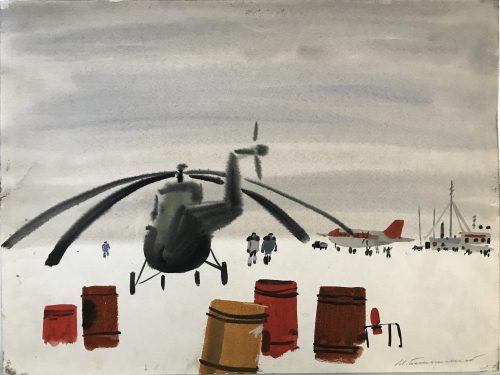 Mikhail Belomlinsky. Born 1934, Russia. Helicopter. Watercolor painting on paper from Chukotka expedition, 1975. Size: 36 x 48 cm.
Mikhail Belomlinsky. Born 1934, Russia. Helicopter. Watercolor painting on paper from Chukotka expedition, 1975. Size: 36 x 48 cm. -
 Artist: Horst Graebner positively attributes the drawing to Utagawa Kunisada II [歌川国貞] Japanese, 1823 – 1880) a.k.a. Toyokuni IV, though Israel Goldman attributes it to Utagawa Kunisada [歌川 国貞] (Japanese, 1786 – 1865) a.k.a. Utagawa Toyokuni III. Title: Geisha with a watch / Preparatory drawing for a fan print. Media/Technique: Ink and colour on paper. Signed: Toyokuni hitsu [豊国筆].
Artist: Horst Graebner positively attributes the drawing to Utagawa Kunisada II [歌川国貞] Japanese, 1823 – 1880) a.k.a. Toyokuni IV, though Israel Goldman attributes it to Utagawa Kunisada [歌川 国貞] (Japanese, 1786 – 1865) a.k.a. Utagawa Toyokuni III. Title: Geisha with a watch / Preparatory drawing for a fan print. Media/Technique: Ink and colour on paper. Signed: Toyokuni hitsu [豊国筆]. -
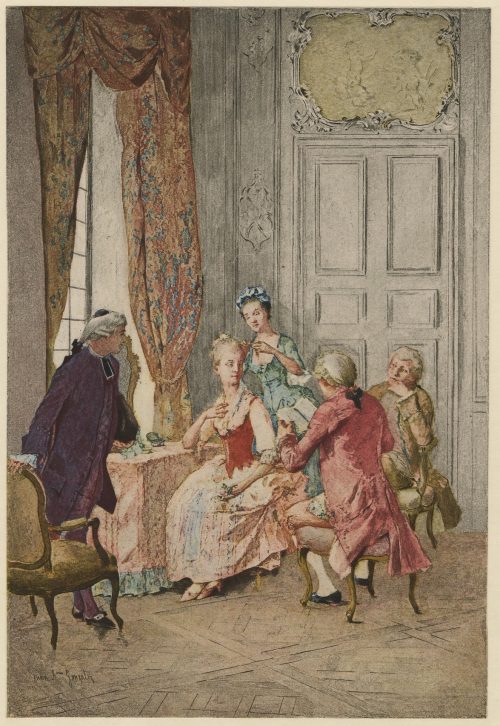
Coloured etching by E. Charreyre (French, fl. 1880 – ?) after a watercolour by Juan Antonio González, (Spanish, 1842 – 1914). A book illustration for 'Son Altesse La Femme' by Octave Uzanne (1851 – 1931), chapter: 'La Caillette' (Le lever d’une petite-maitresse au XVIIIe siècle). Published by Albert Quantin (French, 1850 – 1930) in 1885.
Size: print 17.5 x 12 cm, pasted to leaf 27.7 x 19.5 cm.
-
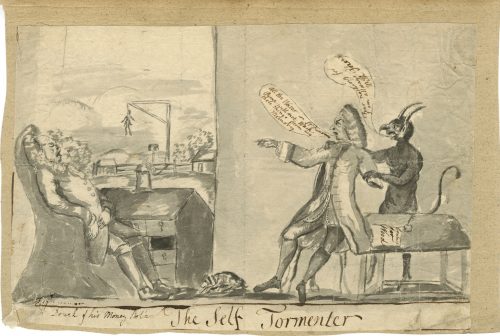 Ink drawing on watermarked paper by an anonymous artist, British or American. Original pen and ink with manuscript text. About 7 x 10-1/2 inches, Vander Ley type watermark (Churchill 321), mounted to old laid paper; several corners chipped, some creasing, soiling, etc. Np, Late 18th-century.
Ink drawing on watermarked paper by an anonymous artist, British or American. Original pen and ink with manuscript text. About 7 x 10-1/2 inches, Vander Ley type watermark (Churchill 321), mounted to old laid paper; several corners chipped, some creasing, soiling, etc. Np, Late 18th-century. -
 Artist: Utagawa Kunisada [歌川 国貞] a.k.a. Utagawa Toyokuni III [三代歌川豊国] (Japanese, 1786 – 1865). Artists signature: Kunisada ga [国貞画] in a red double-gourd cartouche. Character: Kabuki actor Ichikawa Danjūrō VII [七代目 市川 團十郎]; other names: Ichikawa Ebizō V, Ichikawa Shinnosuke I (Japanese, 1791 – 1859). Series: Six choice modern flowers [當世六花撰] (Tosei rok’kasen). No publisher's seal, no date or censor's seal is present. Size: Fan print (aiban uchiwa-e); 232 x 289 mm. Provenance: Paul F. Walter. Izzard: "... six prints make up this set of fan prints, which compares contemporary artists with classic poets, in this case, Ichikawa Danjūrō VII with Ōtomo no Kuronushi [大友 黒主] (Japanese, dates unknown)". Rok'kasen [六歌仙] – six poetry immortals. According to Izzard, identification of the portrayed person is made possible by mimasu-mon [三升] on the robe, scrolling peony on the back of the mirror, and cloth decorated with the characters Yauan, one of the actor's poetry names, and other signs and symbols, including the inscription of the acter's guild name Naritaya. The absence of the publisher’s emblem and censorship seals may indicate that this was a privately issued print, not for public use. Ref: (1) [LIB-2967.2022] Utagawa Kunisada (1786 – 1865): His world revisited / Catalogue № 17, Exhibition March 17-21, 2021. — NY: Sebastian Izzard, LLC., 2021; p. 130-1, fig. 42). (2) Lyon Collection. Mimasu-mon, or Mitsumasu, is the Ichikawa Danjūrō family crest – three wooden measures, nested square boxes.
Artist: Utagawa Kunisada [歌川 国貞] a.k.a. Utagawa Toyokuni III [三代歌川豊国] (Japanese, 1786 – 1865). Artists signature: Kunisada ga [国貞画] in a red double-gourd cartouche. Character: Kabuki actor Ichikawa Danjūrō VII [七代目 市川 團十郎]; other names: Ichikawa Ebizō V, Ichikawa Shinnosuke I (Japanese, 1791 – 1859). Series: Six choice modern flowers [當世六花撰] (Tosei rok’kasen). No publisher's seal, no date or censor's seal is present. Size: Fan print (aiban uchiwa-e); 232 x 289 mm. Provenance: Paul F. Walter. Izzard: "... six prints make up this set of fan prints, which compares contemporary artists with classic poets, in this case, Ichikawa Danjūrō VII with Ōtomo no Kuronushi [大友 黒主] (Japanese, dates unknown)". Rok'kasen [六歌仙] – six poetry immortals. According to Izzard, identification of the portrayed person is made possible by mimasu-mon [三升] on the robe, scrolling peony on the back of the mirror, and cloth decorated with the characters Yauan, one of the actor's poetry names, and other signs and symbols, including the inscription of the acter's guild name Naritaya. The absence of the publisher’s emblem and censorship seals may indicate that this was a privately issued print, not for public use. Ref: (1) [LIB-2967.2022] Utagawa Kunisada (1786 – 1865): His world revisited / Catalogue № 17, Exhibition March 17-21, 2021. — NY: Sebastian Izzard, LLC., 2021; p. 130-1, fig. 42). (2) Lyon Collection. Mimasu-mon, or Mitsumasu, is the Ichikawa Danjūrō family crest – three wooden measures, nested square boxes.
-
 Utagawa Kunisada [歌川 国貞] a.k.a. Utagawa Toyokuni III [三代歌川豊国] (Japanese, 1786 – 1865). Signed: Toyokuni ga [豊国 画] in a yellow toshidama cartouche. Publisher: Unknown, seal [久] Kyū (Japanese, fl. c. 1851 – 1861); (Marks 07-023 | U176a, possibly Sagamia Kyūzō). Block carver: Koizumi Minokichi [小泉巳の吉] (Japanese, 1833 – 1906); seal: Hori Mino [彫已の] (Gordon Friese № 38). Date seal and double nanushi censor seals: Fuku & Muramatsu, Kaei 6, 2nd month (2/1853). Inscription in a red cartouche: (Purple of Edo // Purple of the Bay Capital) [江都むらさき] (Edo Murasaki), alluding to Murasaki Shikibu [紫 式部] (Japanese, c. 973/8 – c. 1014/31), the author of Genji Monogatari [源氏物語] (The Tale of Genji), a Heian period novel which was the source of a parody Nise Murasaki Inaka Genji [偐紫田舎源氏] (Fake Murasaki’s Rustic Genji) by Ryutei Tanehiko [柳亭種彦] (Japanese, 1783 – 1842). According to Horst Graebner: The actor is most probably Segawa Kikunojō V. Segawa Kikunojō V [瀬川菊之丞] (Japanese, 1802 – 1832); other names: Segawa Tamon I. One of the series of Kunisada's fan prints in this collection:
Utagawa Kunisada [歌川 国貞] a.k.a. Utagawa Toyokuni III [三代歌川豊国] (Japanese, 1786 – 1865). Signed: Toyokuni ga [豊国 画] in a yellow toshidama cartouche. Publisher: Unknown, seal [久] Kyū (Japanese, fl. c. 1851 – 1861); (Marks 07-023 | U176a, possibly Sagamia Kyūzō). Block carver: Koizumi Minokichi [小泉巳の吉] (Japanese, 1833 – 1906); seal: Hori Mino [彫已の] (Gordon Friese № 38). Date seal and double nanushi censor seals: Fuku & Muramatsu, Kaei 6, 2nd month (2/1853). Inscription in a red cartouche: (Purple of Edo // Purple of the Bay Capital) [江都むらさき] (Edo Murasaki), alluding to Murasaki Shikibu [紫 式部] (Japanese, c. 973/8 – c. 1014/31), the author of Genji Monogatari [源氏物語] (The Tale of Genji), a Heian period novel which was the source of a parody Nise Murasaki Inaka Genji [偐紫田舎源氏] (Fake Murasaki’s Rustic Genji) by Ryutei Tanehiko [柳亭種彦] (Japanese, 1783 – 1842). According to Horst Graebner: The actor is most probably Segawa Kikunojō V. Segawa Kikunojō V [瀬川菊之丞] (Japanese, 1802 – 1832); other names: Segawa Tamon I. One of the series of Kunisada's fan prints in this collection: -
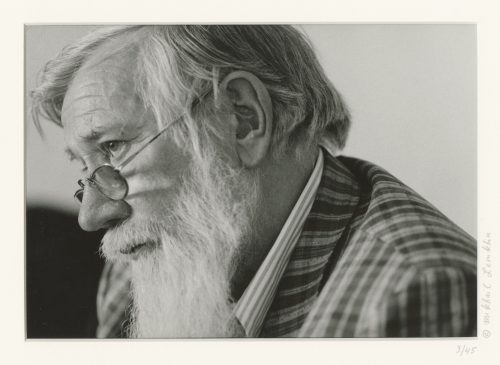 Photographic portrait of writer Andrei Sinyavsky, head and shoulder, turned to the left, wearing glasses. Pencil-signed on the mat: 3/45 • ©Mikhail Lemkhin; on the back of the print: Copyright statement stamp; ink stamp ©MIKHAIL LEMKHIN; ink stamp: PHOTO BY MIKHAIL LEMKHIN | 1811 38TH AVENUE | SAN FRANCISCO, CA 94122 | (415) 664-7677; pencil inscription on the back of the mat: (top) АНДРЕЙ СИНЯВСКИЙ | ANDREI SINYAVSKY, (bottom) XXIX. Sitter: Andrei Sinyavsky [Андрей Донатович Синявский] (Russian, 1925 – 1997) Size: mat: 35.6 x 43.3 cm; window: 16.5 x 23.5 cm; print: 20.2 x 25.2 cm.
Photographic portrait of writer Andrei Sinyavsky, head and shoulder, turned to the left, wearing glasses. Pencil-signed on the mat: 3/45 • ©Mikhail Lemkhin; on the back of the print: Copyright statement stamp; ink stamp ©MIKHAIL LEMKHIN; ink stamp: PHOTO BY MIKHAIL LEMKHIN | 1811 38TH AVENUE | SAN FRANCISCO, CA 94122 | (415) 664-7677; pencil inscription on the back of the mat: (top) АНДРЕЙ СИНЯВСКИЙ | ANDREI SINYAVSKY, (bottom) XXIX. Sitter: Andrei Sinyavsky [Андрей Донатович Синявский] (Russian, 1925 – 1997) Size: mat: 35.6 x 43.3 cm; window: 16.5 x 23.5 cm; print: 20.2 x 25.2 cm. -
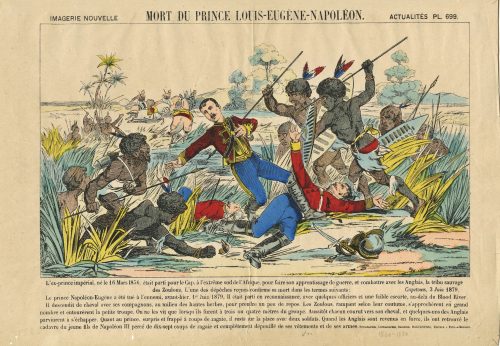 Hand-coloured lithography on wove paper, 275 x 385 mm; vertical centerfold, image in frame. On reverse: black ink stamp “5350”. Above the frame: "IMAGERIE NOUVELLE — MORT DU PRINCE LOUIS-EUGÈNE-NAPOLÉON. — ACTUALITÉS PL. 699". Under the frame: "L'ex-prince impérial, né le 16 Mars I856, était parti pour le Cap, à l'extrême sud de l'Afrique, pour faire son apprentissage de guerre, et combattre avec les Anglais, la tribu sauvage des Zoulous. L'une des dépêches reçues confirme sa mort dans les termes suivants: — Capetown, 3 Juin 1879. — Le prince Napoléon-Eugène a été tué à l'ennemi, avant-hier, 1er Juin 1879, Il était parti en reconnaissance, avec quelques officiers et une fable escorte, au-delà du Blood River. Il descendit de cheval ave ses compagnons, au milieu des hautes herbes, pour prendre un peu de repos. Les Zoulous, rampant selon leur coutume, s'approchèrent en grand nombre et entourèrent la petite troupe. On ne les vit que lorsqu' ils furent à trois ou quatre mètres du groupe. Aussitôt chacun court vers son cheval, et quelques-uns des Anglais parvinrent à s'échapper. Quant au prince, surpris et frappé à coups de zagaie, il resta sur la place avec deux soldats. Quand les Anglais sont revenus en force, ils ont retrouvé le cadavre du jeune fils de Napoléon III percé de dix-sept coups de zagaie et complétement dépouillé de ses vêtements et de ses armes". — "Typographie, Lithographie, Imagerie, Haguenthal, Éditeur à Pont-à-Mousson". Pencil ms: "1860-1880". Élie Haguenthal (French, 1822 – 1881) – publisher/printer.
Hand-coloured lithography on wove paper, 275 x 385 mm; vertical centerfold, image in frame. On reverse: black ink stamp “5350”. Above the frame: "IMAGERIE NOUVELLE — MORT DU PRINCE LOUIS-EUGÈNE-NAPOLÉON. — ACTUALITÉS PL. 699". Under the frame: "L'ex-prince impérial, né le 16 Mars I856, était parti pour le Cap, à l'extrême sud de l'Afrique, pour faire son apprentissage de guerre, et combattre avec les Anglais, la tribu sauvage des Zoulous. L'une des dépêches reçues confirme sa mort dans les termes suivants: — Capetown, 3 Juin 1879. — Le prince Napoléon-Eugène a été tué à l'ennemi, avant-hier, 1er Juin 1879, Il était parti en reconnaissance, avec quelques officiers et une fable escorte, au-delà du Blood River. Il descendit de cheval ave ses compagnons, au milieu des hautes herbes, pour prendre un peu de repos. Les Zoulous, rampant selon leur coutume, s'approchèrent en grand nombre et entourèrent la petite troupe. On ne les vit que lorsqu' ils furent à trois ou quatre mètres du groupe. Aussitôt chacun court vers son cheval, et quelques-uns des Anglais parvinrent à s'échapper. Quant au prince, surpris et frappé à coups de zagaie, il resta sur la place avec deux soldats. Quand les Anglais sont revenus en force, ils ont retrouvé le cadavre du jeune fils de Napoléon III percé de dix-sept coups de zagaie et complétement dépouillé de ses vêtements et de ses armes". — "Typographie, Lithographie, Imagerie, Haguenthal, Éditeur à Pont-à-Mousson". Pencil ms: "1860-1880". Élie Haguenthal (French, 1822 – 1881) – publisher/printer. -
 Three-quarter half-length seated portrait of American filmmaker and actor Woody Allen in a scene from the drama film The Front (1976), shot by Columbia Pictures in 1976, autographed on a light area of the image. Dimensions: 245 x 192 mm; image 217 x 192 mm.
Three-quarter half-length seated portrait of American filmmaker and actor Woody Allen in a scene from the drama film The Front (1976), shot by Columbia Pictures in 1976, autographed on a light area of the image. Dimensions: 245 x 192 mm; image 217 x 192 mm. -
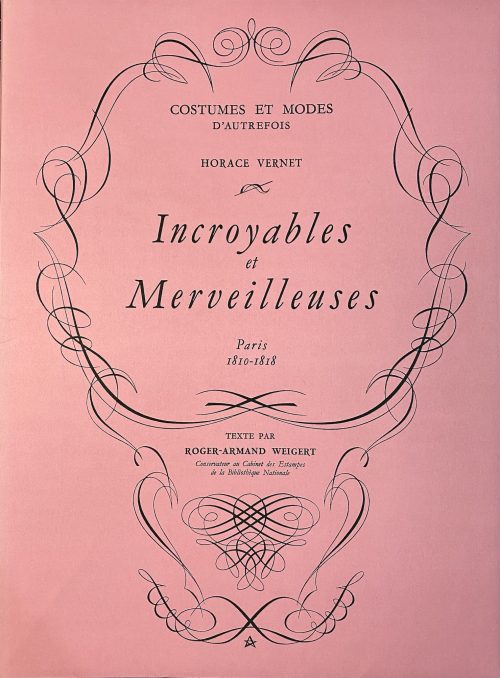 Title: COSTUMES ET MODES | D’AUTREFOIS | HORACE VERNET | Incroyables | et | Merveilleuses | Paris | 1810–1818 | TEXTE PAR | ROGER–ARMAND WEIGERT | Conservateur au Cabinet des Estampes | de la Bibliothèque Nationale | ÉDITIONS ROMBALDI | PARIS || Content: 24 photomechanical reproductions of the images from Bibliothèque nationale de France, printed on vélin paper from Papeteries Aussedat by Papeteries de la Moselle printing presses and stencil-coloured by Edmond Vairel. Text printed by Imprimerie Kapp on October 20, 1955. A print run of 4,000 copies, of which this is №122. Exterior: Pink lettered dust jacket over wrappers. Pagination: loose double leaves, [4 blanks] [4 h.t. and t.p.], i-xi [xii], 24 unnumbered plates, [4 blanks].
Title: COSTUMES ET MODES | D’AUTREFOIS | HORACE VERNET | Incroyables | et | Merveilleuses | Paris | 1810–1818 | TEXTE PAR | ROGER–ARMAND WEIGERT | Conservateur au Cabinet des Estampes | de la Bibliothèque Nationale | ÉDITIONS ROMBALDI | PARIS || Content: 24 photomechanical reproductions of the images from Bibliothèque nationale de France, printed on vélin paper from Papeteries Aussedat by Papeteries de la Moselle printing presses and stencil-coloured by Edmond Vairel. Text printed by Imprimerie Kapp on October 20, 1955. A print run of 4,000 copies, of which this is №122. Exterior: Pink lettered dust jacket over wrappers. Pagination: loose double leaves, [4 blanks] [4 h.t. and t.p.], i-xi [xii], 24 unnumbered plates, [4 blanks].Weigert, Roger-Armand (French, 1907-1986).
Émile Jean-Horace Vernet [Horace Vernet] (French, 1789 – 1863). Gatine, Georges Jacques (French, 1773 – after 1841). -
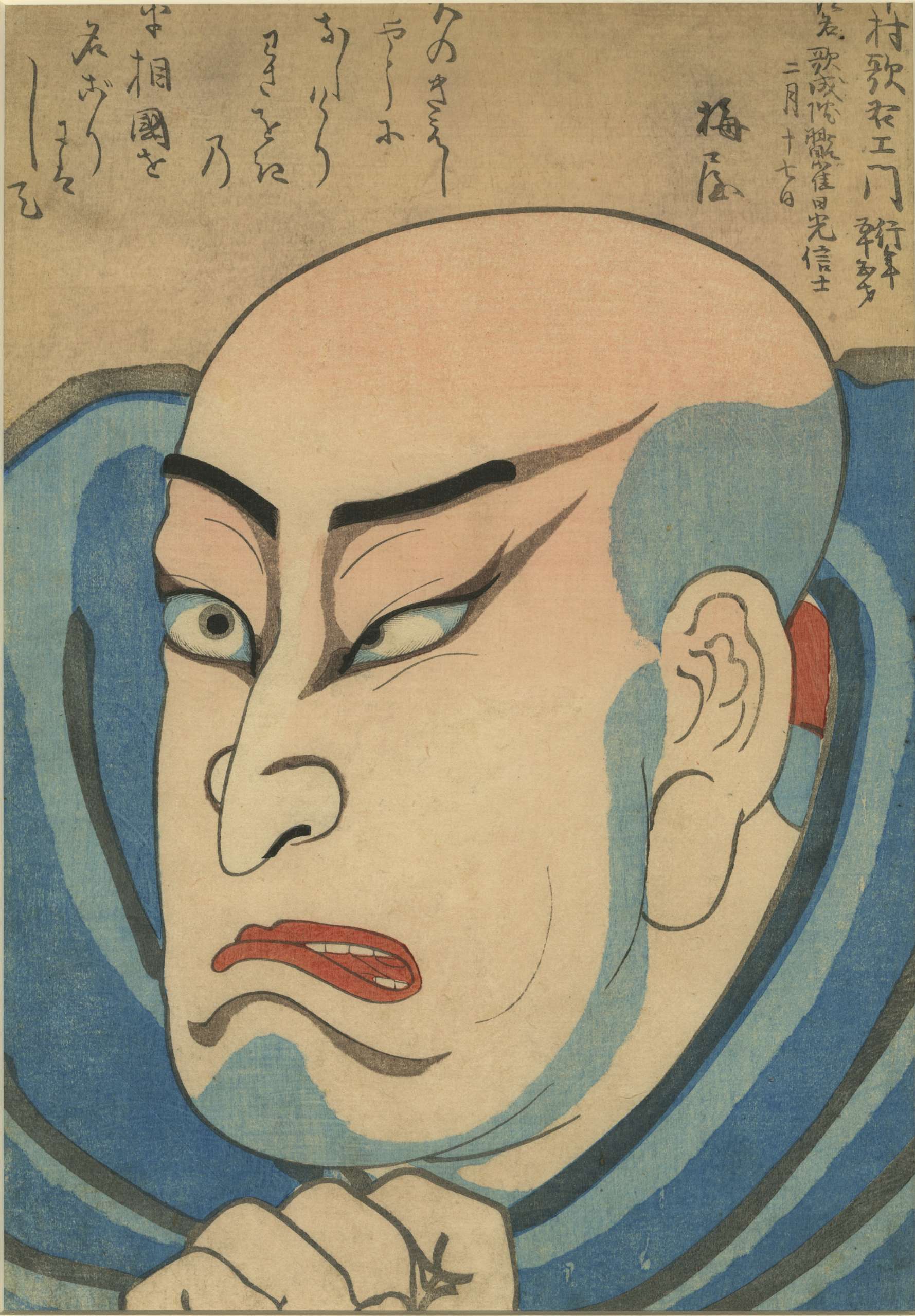 Utagawa Kuniyoshi, 歌川 国芳, January 1, 1797 – April 14, 1861. Memorial portrait (Shini-e) of Nakamura Utaemon IV as a priest. Date: 1852. Reference: Heroes and Ghosts, by Robert Schaap, 1998, p. 165 (image 176). Tokyo digital museum 番号 94202582. Provenance: Herbert Egenolf Collection, Germany. Literature: Suzuki (1992) 317. Trimmed, unsigned.
Utagawa Kuniyoshi, 歌川 国芳, January 1, 1797 – April 14, 1861. Memorial portrait (Shini-e) of Nakamura Utaemon IV as a priest. Date: 1852. Reference: Heroes and Ghosts, by Robert Schaap, 1998, p. 165 (image 176). Tokyo digital museum 番号 94202582. Provenance: Herbert Egenolf Collection, Germany. Literature: Suzuki (1992) 317. Trimmed, unsigned. -
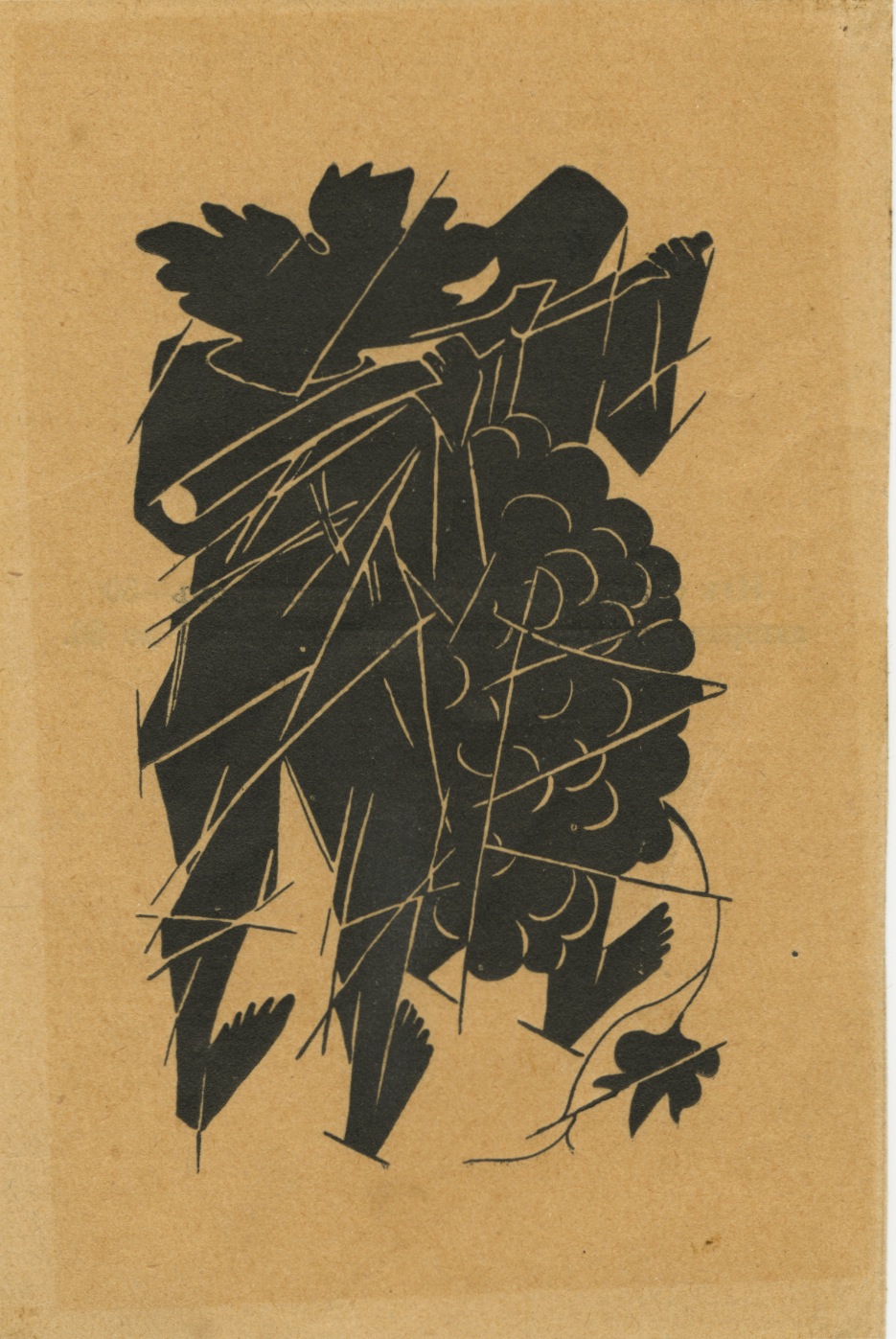 Artist: Natalia Goncharova (July 3, 1881 – October 17, 1962). Russian/French. Lithographic illustration (frontispiece) for Sergei Bobrov book of poetry "The gardeners upon the grapevines", Moscow, Lirika Publishers, 1913. Size: 18 х 11,5 cm.
Artist: Natalia Goncharova (July 3, 1881 – October 17, 1962). Russian/French. Lithographic illustration (frontispiece) for Sergei Bobrov book of poetry "The gardeners upon the grapevines", Moscow, Lirika Publishers, 1913. Size: 18 х 11,5 cm.Book was printed on May 20, 1913 for Lirika Publishers, by V. I. Voronov printshop in 500 copies, of them 50 authored and numbered. 10 lithographs by Natalia Goncharova printed at Kushneryov & Co. lithography in Moscow.
Наталия Гончарова (3 июля 1881 – 17 октября 1962). Россия/Франция. Литографическая иллюстрация (фронтиспис) к книге С. П. Боброва "Вертоградари над лозами" [Сергей Бобров. М.: /Лирика, 1913]. Формат: 18 х 11,5 см.Тираж 500 экз, из них 50 авторизованных и нумерованных. Десять цветных рисунков работы Н. Гончаровой исполнены в технике литографии на отдельных листах. Книга отпечатана 20 мая 1913 года в типографии В.И. Воронова для книгоиздательства «Лирика». В мягкой издательской обложке. На с. 162 после списка литографий: Отпечатаны литографией т-ва И.Н. Кушнерев и К° в Москве.
-
 Utagawa Kunisada [歌川 国貞]; a.k.a. Utagawa Toyokuni III [三代歌川豊国] (Japanese, 1786 – 1865). Signed: Toyokuni ga [豊国 画] in a red toshidama cartouche. Publisher: Ibaya Senzaburō [伊場屋仙三郎] (Japanese, fl. 1815 – 1869). Block carver: Yokokawa Takejirō [横川竹二郎] (Japanese, fl. 1845 – 1863), seal: 彫竹 – Hori Take. Date seal and aratame censor seal: May of the Year of Dragon [辰五] (Tatsu-go) (5/1856) (Not in Marks).
Utagawa Kunisada [歌川 国貞]; a.k.a. Utagawa Toyokuni III [三代歌川豊国] (Japanese, 1786 – 1865). Signed: Toyokuni ga [豊国 画] in a red toshidama cartouche. Publisher: Ibaya Senzaburō [伊場屋仙三郎] (Japanese, fl. 1815 – 1869). Block carver: Yokokawa Takejirō [横川竹二郎] (Japanese, fl. 1845 – 1863), seal: 彫竹 – Hori Take. Date seal and aratame censor seal: May of the Year of Dragon [辰五] (Tatsu-go) (5/1856) (Not in Marks). Uncut fan print (uchiwa-e) depicting Onoe Kikugorō IV as Karukaya Dōshin parting from his son, Ishidomaru (played by Ichimura Uzaemon XIII), and Kawarasaki Gonjūrō I as Yamazakiya Yogoro in the kabuki play Karukaya Dōshin Tsukushi no Iezuto [苅萱桑門筑紫𨏍], written by Namiki Sōsuke [並木宗輔] (Japanese, 1695 – 1751) and performed at Ichimuraza [市村座] in 05/1856.
Media: Fan print [団扇絵] (Uchiwa-e); size: 235 x 305 mm.
Actors:
Onoe Kikugorō IV [四代目 尾上菊五郎] (Japanese, 1808 – 1860); other names: Onoe Baikō IV, Onoe Eizaburō III, Onoe Kikue, Nakamura Tatsuzō, Nakamura Kachō.
Onoe Kikugorō V [五代目尾上菊五郎] (Japanese, 1844 – 1903 other names: Onoe Baikō V, Ichimura Kakitsu IV, Ichimura Uzaemon XIII [十三代目市村羽左衛門], Ichimura Kurōemon.
Ichikawa Danjūrō IX [市川団十郎] (Japanese, 1838 – 1903); other names: Kawarasaki Sanshō, Kawarasaki Gonnosuke VII, Kawarasaki Gonjūrō I, Kawarasaki Chōjūrō III.
Plot: It was a popular belief at one time that jealous women had their hair transformed into writhing serpents and Kato Sayemon Shige-Uji, a daimyo of Tsukushi, a much-married man, suffered from the delusion that his wife was so affected. He fled to the mountains to escape her and led the life of a hermit under the name of Karukaya Doshin [苅萓道心]. One day, on Mount Kōya (高野山, Kōyasan) Karukaya meets a young man who was wandering in the mountains. Being questioned, the youth tells his name, Ishidomaru, and elicits the information that he is seeking his lost father. Karukaya then recognizes the boy as his own son, but firm in the resolve to remain lost to the world, he refrains from disclosing himself, and bids the youth return home.
Provenance: Paul F. Walter (American, 1935 – 2017).
Ref.:
Uncut fan print (uchiwa-e) depicting Onoe Kikugorō IV as Karukaya Dōshin parting from his son, Ishidomaru (played by Ichimura Uzaemon XIII), and Kawarasaki Gonjūrō I as Yamazakiya Yogoro in the kabuki play Karukaya Dōshin Tsukushi no Iezuto [苅萱桑門筑紫𨏍], written by Namiki Sōsuke [並木宗輔] (Japanese, 1695 – 1751) and performed at Ichimuraza [市村座] in 05/1856.
Media: Fan print [団扇絵] (Uchiwa-e); size: 235 x 305 mm.
Actors:
Onoe Kikugorō IV [四代目 尾上菊五郎] (Japanese, 1808 – 1860); other names: Onoe Baikō IV, Onoe Eizaburō III, Onoe Kikue, Nakamura Tatsuzō, Nakamura Kachō.
Onoe Kikugorō V [五代目尾上菊五郎] (Japanese, 1844 – 1903 other names: Onoe Baikō V, Ichimura Kakitsu IV, Ichimura Uzaemon XIII [十三代目市村羽左衛門], Ichimura Kurōemon.
Ichikawa Danjūrō IX [市川団十郎] (Japanese, 1838 – 1903); other names: Kawarasaki Sanshō, Kawarasaki Gonnosuke VII, Kawarasaki Gonjūrō I, Kawarasaki Chōjūrō III.
Plot: It was a popular belief at one time that jealous women had their hair transformed into writhing serpents and Kato Sayemon Shige-Uji, a daimyo of Tsukushi, a much-married man, suffered from the delusion that his wife was so affected. He fled to the mountains to escape her and led the life of a hermit under the name of Karukaya Doshin [苅萓道心]. One day, on Mount Kōya (高野山, Kōyasan) Karukaya meets a young man who was wandering in the mountains. Being questioned, the youth tells his name, Ishidomaru, and elicits the information that he is seeking his lost father. Karukaya then recognizes the boy as his own son, but firm in the resolve to remain lost to the world, he refrains from disclosing himself, and bids the youth return home.
Provenance: Paul F. Walter (American, 1935 – 2017).
Ref.:
- [LIB-2110.2019] Samuel L. Leiter. Historical Dictionary of Japanese Traditional Theatre (Historical Dictionaries of Literature and the Arts). / 2nd edition. – Lanham: Rowman & Littlefield, 2014; pp. 379-380.
- [LIB-2206.2019] Basil Stewart. Subjects portrayed in Japanese colour-prints. — London: Kegan Paul, Trench, Trubner & Co. Ltd., 1922.



